
Methods and Techniques
BAKING CAKES
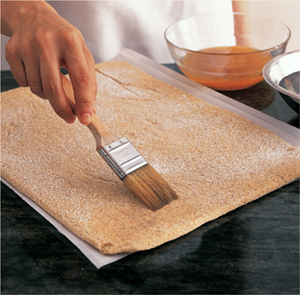
While it seems there are hundreds of different kinds of cakes, there are really only six: sponge cakes, butter cakes, oil-based cakes (such as carrot cake and chiffon cake), yeasted cakes (including babas and savarins), meringue-based cakes, and custard cakes (cheesecake, for example). Once you know how to make one of each type, you’ll know how to make them all.
Four basic ingredients make virtually all cakes and pastries what they are: flour, eggs, sugar, and butter. Cakes can be made with other ingredients, such as flavorings (nuts, chocolate, fruits) and leavenings (baking powder and baking soda), but the amazing variety is the result of manipulating the four basic ingredients in different ways.
Flour is the most essential ingredient for practically all cakes because it becomes firm when hot so that air stays trapped in the cake even after it has cooled. Virtually no cake can exist without eggs; they set at a lower temperature than flour so your cake doesn’t fall while it is getting hot enough to set the flour, and they trap air, which keeps the cake light. Most cakes are sweetened with sugar or something closely related, such as honey. Other than sweetening the cake, sugar helps keep a cake tender; when beaten with butter, it helps entrap air. Butter isn’t used in all cakes, but when it is, it imparts an ineffable flavor and finesse and keeps the flour from getting tough.
Most of us associate cakes with the classic tall round layer cakes we’ve feasted on at birthday parties. Less festive, but easier because they require no assembly, are flat sheet cakes. To make a round layer cake, you can cut one cake into two or three or even more layers using a serrated knife—slicing more than two layers takes a little practice—and put filling in between, or you can bake two layer cakes and cut each of these in half or in thirds. Most of the cake recipes given here are for one, or sometimes two, 9-inch round layer cakes—the size cake pan found in most home kitchens—typically 1 to 1½ inches thick.
The amount of batter for two 9-inch round layer cakes are the same as for a sheet cake baked in a classic 13 by 17-inch sheet pan with 1-inch-high sides. (There are slight variations in brands of sheet pans, but anything within an inch of these dimensions will work. Cakes sometimes rise over the edge of the sheet pan, which is fine.) If you’re making a square or rectangular cake, just cut a sheet cake into the size you want and slice into layers. You can also roll some very moist sheet cakes.
European-style cakes are usually smaller, both shorter and with a smaller diameter, than American cakes—6-inch cakes that serve four are common. A recipe for one 9-inch cake can be used to make two 6-inch cakes.
Some very elegant cakes with lots of layers are made by piping disks of cake batter onto parchment paper–lined sheet pans or into round cake pans. These disks can be made very thin—with a ¼-inch plain tip or smaller—and come in handy when you need thin layers that would be impossible to obtain by slicing a cake crosswise.
This cakes section is divided into four parts: making basic cakes (such as butter cakes and foam cakes); making frostings, fillings, and glazes (such as buttercream); assembling cakes; and decorating cakes. Each finished cake is designed to teach more than one recipe or technique that can be used for many more cakes than just the one shown, and when the fillings and assembly techniques are mixed and matched, you can improvise many dozens of cakes by using different cakes, frostings, glazes, and fillings.
While cake recipes have to be pretty exact and don’t give a lot of leeway for improvisation, the fillings do. They can be flavored in many different ways with fruits, spices, coffee, chocolate, and spirits, and they can even be combined. If you make cakes a lot and find yourself with leftover frostings or fillings, save them in the freezer. You can combine them at some point as long as the flavors make sense. In other words, if you have a little leftover lemon curd, a bit of mango crème mousseline, maybe some vanilla pastry cream, or some kirsch-flavored buttercream, these can all be beaten together.
Again, virtually all cakes are of only six kinds, which are presented here in a logical way. Sponge cakes are divided into three basic kinds: those made with whole eggs, those made with separated whites and yolks, and those made with whites only. Butter cakes are also divided into three kinds: the classic kind, of which pound cake is the most fundamental; those that are basically sponge cakes but with lots of melted butter or cream added; and high-ratio cakes, developed in the 1930s (see Almond Paste Sponge Cake). Next are oil-based cakes, such as carrot cake; yeasted cakes, such as babas and savarins; meringues, made with egg whites and sometimes nuts or chocolate; followed by custard cakes, cheesecake being the prime example.
The next section describes frostings, fillings, and glazes and starts with two kinds of buttercream, a professional version and an easy homespun version; followed by two kinds of frosting made with chocolate and cream; white and dark chocolate glazes; white and dark chocolate mousses, which make excellent fillings; fruit mousses; Bavarian creams, which can be flavored with virtually anything; crème mousseline, which is much like buttercream but is stabilized with pastry cream; fruit curds; egg white–based frostings and fillings; stabilized whipped cream, which can be used as a lighter frosting or filling; and a fondant that can be rolled and used to cover a cake.
The following section, devoted to the assembly of finished cakes, shows how to use the cakes and fillings given in the earlier sections. Each cake is designed to teach a technique that’s useful for far more cakes than just the cake shown. For example, the chocolate hazelnut cake is designed to show you how to use a cake stand and what I call the “free form” technique. The raspberry buttercream layer cake shows how to assemble a cake without a cake stand. The orange buttercream cake is a lesson in how to make a rectangular cake and how to flavor a buttercream with orange. The dark chocolate mousse cake is an example of how to use mousse as a filling and how to make a perfectly even, professional-looking cake by constructing it in a springform pan. The strawberry and white chocolate mousse cake demonstrates how to make a cake with a filling that starts out with a liquid and how to decorate a cake with rows of ladyfingers. The mango mousseline cake shows how to make a buttery frosting with virtually any fruit and how to make miniature cookies for decoration. An elaborate strawberry cake is an example of how to decorate the sides of a square cake with fruit and how to use marzipan to give a polished look, very easily, to a finished cake.
One method, more popular in Europe than in the United States, is to brush cake layers with a light sugar syrup that’s been flavored with a little coffee, vanilla, liqueur, fruit brandy, whiskey, Cognac, or rum. The advantage to this is that the cake is always moist, even if it started out stale. If you make cakes in this way, you can save up the basic cakes, tightly wrapped, in the freezer, and then just assemble them at the last minute. If you’re ambitious, you might want to make several kinds of cakes, maybe with contrasting flavors and colors and textures, so that when you assemble a cake you can use a variety of different layers. Fillings are a little trickier to store than cakes because they are emulsions, usually of cream or butter, which can separate when frozen and thawed. Most of the time, a separated filling such as a buttercream can be warmed slightly—just put it in a metal bowl and stir it with a whisk over a low flame for 30 seconds—and then beaten, first with a paddle attachment and then with a whisk. But there’s never a need to waste a filling, even one that won’t cooperate when you try to beat it back to life. If you have hopelessly broken buttercream or ganache, for example, beat it into a little batch of pastry cream to make a crème mousseline.
Another European trick that’s an easy way to make perfectly even and smooth cakes that look truly professional is to assemble your cakes in a springform pan or in a cake ring with a cardboard bottom. This allows you to use liquid ingredients such as Bavarian creams and also keeps the sides of the cake perfectly even.
When you’ve assembled your cake, either a simple cake with one kind of cake layer and one kind of filling or a complex cake with assorted fillings and layers, there are many choices, some very simple, for giving it a professional look. One of the easiest is simply to press cake crumbs or chopped nuts against the sides. More complicated are such things as meringue logs, wide chocolate strips, rounds of rolled cake on the outside of a dome cake, strips of ladyfingers wrapped around the cake, shiny colored mirrors made from fruit purees for the tops of the cakes, decoration with royal icing, sheets of marzipan or fondant simply rolled over the cake—all can be used to give any cake a dramatic impact.
Because the outside rim of a cake is heated first, it can cook before the center, causing the edges of the cake to rise less and hold their shape, while the center, which cooks more evenly and slowly, rises to form a dome. To prevent this, wrap a wet towel around the cake pan. This technique slows down the cooking of the outside edge and results in a cake that is perfectly flat on top.
There is nothing more frustrating than laboring over a cake and then having it stick to the pan. Most of us butter and flour cake pans to prevent sticking, and most of the time this works. But to be absolutely certain the cake comes out of the pan with its surface perfectly smooth, butter the inside of the pan, cover the pan bottom with a round of buttered parchment paper, and then flour the inside of the pan and the paper. Don’t cut the round of paper any larger than the pan; if it extends up the sides around the edges it will make a rough edge on the cake. On the other hand, it’s fine if the parchment paper is slightly smaller than the cake pan. To butter and flour a cake pan, brush the inside of the pan with room-temperature butter, put a handful of flour in the pan, and rotate it until the bottom and sides are coated with flour. Invert the pan and tap it against the work surface to shake out any excess flour.
To butter the molds: Use room-temperature butter, which will provide a thicker coat than melted butter. If you need an especially thick coating of butter, such as when making madeleines, place the butter-coated molds in the refrigerator for a few minutes and then coat them again.

1. Place a cake pan on a sheet of parchment paper and draw a circle around it. Cut out the circle to make a round of parchment paper.

2. Thoroughly brush the cake pan with room-temperature butter and press the parchment paper into the pan—the butter holds the parchment paper in place.

3. Brush the parchment paper with butter. Put flour in the pan and rotate the pan until it is thoroughly coated. Invert the pan and tap it to shake off any excess flour.
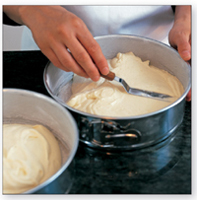
4. An offset spatula is an ideal tool for smoothing the top of the cake batter.

To coat a ramekin with flour or cocoa powder, butter it and fill it with sifted cocoa powder or flour and rotate so that the ramekin’s sides are coated. Pour any excess cocoa powder or flour into the next ramekin.
To coat buttered molds with flour or cocoa powder: put the flour or cocoa powder in one of the molds and rotate it so that it leaves a light coating on the bottom and sides. Transfer the excess to the next mold by inverting the powder-coated mold and giving it a good tap to loosen any excess powder.
To fill a cake pan: Most cake batters are easily spread in cake pans with an offset spatula, a very handy gadget that a lot of home cooks don’t have. Scoop smooth cake batter into parchment paper–lined and floured cake pans. Smooth off the top of each pan with an offset spatula. If you don’t have an offset spatula, spread the batter with a rubber spatula or pipe it into the pan with a pastry bag fitted with a ¾-inch plain tip.
It is sometimes convenient to fill a pastry bag with cake batter and then pipe it onto a sheet of parchment paper or into a pan before baking it—for example, when making ladyfingers or cakes with very thin layers. Starting with piped layers is often easier than trying to slice a cake into thin layers with a knife. Virtually any batter, provided it isn’t too runny, can be used in this way.
Here are some useful tips to keep in mind when piping batter:
The thickness of what you’re piping is always somewhat greater than the size of the tip—in other words, a ¼-inch tip will pipe out a layer about ⅓ inch thick.
Draw rings or rectangles on parchment paper to guide your piping, turning the parchment paper over before you pipe so that the batter does not touch the ink or pencil lead.
As you’re piping disks for cake layers, especially if you’re using a very small tip, you’ll probably end up with gaps in the disks where the pastry bag wasn’t positioned exactly where it needed to be. Don’t worry—just smooth over the disks with an offset spatula before you bake them.
Usually, a recipe for a cake that is about 1½ inches thick when baked will make three ⅓-inch-thick disks of batter, instead of four as you might expect.
Piped layers about ⅓ inch thick will bake in 12 minutes in a 375°F oven; 10 minutes in a 400°F oven for thinner, ¼-inch layers. See the photos.
Sponge cakes are cakes made by beating whole eggs, separated eggs, or just egg whites with sugar and then folding the beaten mixture with butter or flavorful ingredients such as chocolate. Last, flour and/or other dry ingredients are folded with the egg mixture. If the cake is based on beaten egg whites instead of whole eggs, the beaten egg yolks are also folded into the mixture. One of the best-known sponge cakes, called biscuit (pronounced bees-kwee), is made by beating egg yolks and egg whites separately, each with sugar, and then folding the two mixtures together while sifting flour over them. American sponge cakes are made in the same way as biscuit except that they usually contain slightly more egg. A whole-egg sponge cake, called a genoise, is made by beating whole eggs with sugar until the eggs quadruple in volume and then sifting the flour over them while folding it in. Most recipes also call for folding in a small amount of melted butter. Both of these cakes, while light and airy, tend to be dry. Because of this, European bakers brush each layer liberally with simple syrup flavored with some kind of fruit brandy, rum, or coffee while stacking them; the cake ends up moist, almost wet. One advantage of this method is that you can moisten cakes that are a little stale (whether from being held too long or from being frozen), so you can bake cakes ahead of time, wrap them in plastic, and freeze them. Both kinds of sponge cakes are leavened only with the air beaten into the eggs. They contain no baking powder or baking soda.
There are many sponge-cake variations—some of which are used for rolled cakes—made by folding various ingredients, such as melted butter, hot cream or milk, or sour cream, with the beaten eggs. Some sponge cakes also contain almond flour or almond paste. A sponge cake made with almond flour or almond paste is flexible, moist, and perfect for rolling because almonds contain no gluten.
Sponge cakes are flavored in several ways. They are made into chocolate cakes by substituting cocoa powder for some of the flour that is folded into the beaten eggs or egg whites, or by folding melted chocolate—sometimes melted with butter—into the egg mixture before folding in the flour.
Whole-egg sponge cakes are made by beating whole eggs with sugar until the mixture triples or quadruples in volume, and then folding the mixture with sifted flour and sometimes melted butter, beurre noisette (brown butter), or melted chocolate.
Basic French Sponge Cake (Genoise)
This is a purist’s cake because it contains no leavening—it’s lightened with air alone—and has a delicate egg flavor and a light texture that make it seem to fall apart in the mouth. To make this classic French sponge cake, you need to beat whole eggs with sugar until they become very pale and are tripled or quadrupled in volume. Because eggs whip up more quickly when they are not ice cold, warm them in a bowl of warm water before cracking them, or use a hand whisk to beat them with the sugar in a bowl placed over a saucepan of barely simmering water until they feel warm to the back of a finger. Beat the egg-sugar mixture until you can lift the whisk and move it back and forth through the batter and the ribbon holds its shape for at least 5 seconds. If you overbeat the eggs, the cake may be dry or, worse, it may fall in the oven. If the eggs are not beaten sufficiently, the cake will be heavy.
Because genoise is often somewhat dry, many bakers—especially French ones—brush each layer generously with flavored simple syrup, making the cake very moist, even wet. The syrup can be flavored with coffee, vanilla, liqueurs such as Grand Marnier, fruit brandies such as kirsch, whiskey, Cognac, or rum.
MAKES 1 ROUND LAYER CAKE (9 BY 1 INCH)
Butter and flour for the cake pan
3 eggs
¼ cup plus 2 tablespoons sugar
½ cup plus 2 tablespoons cake flour
3 tablespoons butter, melted (optional)
Preheat the oven to 350°F. Butter and flour a 9-inch round cake pan, or line the bottom with a round of parchment paper.
Combine the eggs and sugar in a bowl. Unless the egg mixture already feels warm, put the bowl over a saucepan of barely simmering water and whisk until warm and frothy. Beat on high speed with a stand mixer fitted with the whisk attachment for 4 minutes, with a handheld mixer for 20 minutes, or by hand using a bowl and balloon whisk for 12 minutes, or until the ribbon stage: when the beater is lifted, the mixture falls in a wide band onto the surface, forming a figure eight that stays for 5 seconds before dissolving.
Carefully transfer the egg mixture to a large bowl. Fold in the flour by sifting it over the beaten eggs and folding with a rubber spatula. In a smaller bowl, fold together the melted butter and about one-fifth of the egg mixture. Fold the butter-egg mixture into the egg mixture in the larger bowl.
Transfer the batter to the prepared pan and gently smooth the top with an offset spatula. Bake for about 25 minutes, or until the cake bounces back to the touch and a toothpick inserted into the center comes out clean.
Let cool for 5 minutes in the cake pan and then turn out onto a cake rack.
Because whole eggs take longer to beat than egg whites, it is best to beat them using a good-quality stand mixer. You can beat them by hand, but you must use a large balloon whisk and a large deep bowl or you’ll exhaust yourself—beating 3 eggs takes about 12 minutes. You must also be a little ambidextrous (this just takes a little practice), or have a friend you can switch off with. The slowest method of all is to use a handheld mixer, which takes about 20 minutes on high speed to beat 3 eggs. Beating times for all methods increase proportionately with the number of eggs.

1. Unless the egg mixture already feels warm, put the bowl over a saucepan of barely simmering water and whisk with a hand whisk until warm and frothy.

2. Beat the mixture until a ribbon forms when you lift the whisk attachment and move it back and forth over the batter. The batter should also form a ribbon at least 2 inches long between the end of the whisk and the top of the batter and should form a figure eight that stays for at least 5 seconds on the surface of the beaten eggs.
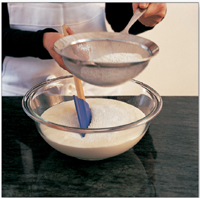
3. Transfer the beaten eggs to a wider bowl—to make folding easier—and sift over the flour while folding.

4. If you are using the melted butter, stir about one-fifth of the cake batter into the butter until smooth and then fold this mixture back into the batter.

5. Gently transfer the batter to a parchment paper–lined or buttered and floured cake pan.
This sponge cake has all the flavor and texture of genoise, but none of the dryness that genoise so often has. It is made just like a classic genoise, except that hot milk or cream and melted butter are folded into the beaten eggs at the same time as the flour, imparting extra moistness that makes it perfect for rolling. When baked in a 13 by 17-inch sheet pan, this moist cake is only about 3⁄8 inch thick, just what you want when making a rolled cake. If you bake this cake as a round cake—in a 9-inch cake pan—you can frost and decorate it in the same way as a genoise.
MAKES 1 SHEET CAKE (13 BY 17 BY 3⁄8 INCH), OR 1 ROUND LAYER CAKE (9 BY 1 INCH)
Butter and flour for the round cake pan, if using
1 teaspoon vanilla extract
¼ cup milk or heavy cream
3 tablespoons butter
3 whole eggs, warmed (see sidebar)
3 egg yolks, warmed (see sidebar)
¾ cup plus 2 tablespoons sugar
¾ cup cake flour
If making a sheet cake, preheat the oven to 400°F and line a 13 by 17-inch sheet pan with parchment paper. If making a round cake, preheat the oven to 350°F and butter and flour a 9-inch round cake pan.
Combine the vanilla, milk, and butter in a small saucepan, bring to a simmer, and cook just long enough to melt the butter. Remove from the heat and set aside.
Using a stand mixer, beat the eggs, egg yolks, and sugar on high speed for about 5 minutes, or until the ribbon stage: when the beater is lifted, the mixture falls in a wide band onto the surface, forming a figure eight that stays for 5 seconds before dissolving.
Carefully transfer the beaten egg mixture to a large bowl to make it easier to fold. Pour the milk-butter mixture down the side of the bowl all at once and fold it in with a rubber spatula quickly but gently. Sift the flour over the bowl and fold it into the egg mixture, one-third at a time, making sure the last batch is incorporated before adding more. Be sure to scrape the spatula along the bottom of the bowl—flour tends to settle there.
Pour the mixture into the prepared pan. If you are making a sheet cake, smooth and spread the mixture with an offset spatula and use your thumb to make a moat around the cake to keep the batter from sticking to the sides of the pan. Bake a sheet cake for about 12 minutes and a round cake for about 25 minutes, or until firm to the touch.
Let the cake cool for 10 minutes until it pulls away from the sides of the pan and then turn it out onto a cooling rack. If you are making a sheet cake, gently pull the parchment paper away from the surface of the cake.
Because eggs froth up better when warm, many recipes call for eggs that have been allowed to come to room temperature or have been warmed even more. To warm eggs quickly, just put them, whole in the shell, in a bowl of hot water from the tap and let them sit for 5 minutes.
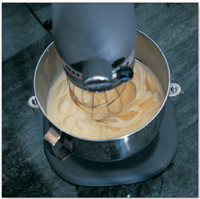
1. Whisk the eggs, egg yolks, and sugar on high speed for about 5 minutes, or until the egg mixture forms a ribbon.

2. Transfer the egg mixture to a wide bowl. Pour the milk mixture down one side of the bowl and fold it quickly but gently with the egg mixture.

3. To make a sheet cake, pour the batter onto a parchment paper–lined sheet pan. Spread the batter with an offset spatula.

4. Make a small moat around the edge of the cake with your thumb.
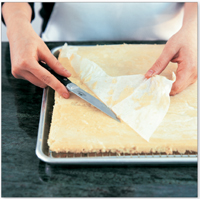
5. When the cake is baked, let it cool for 10 minutes, then invert onto a cooling rack and gently pull away the parchment paper.
In most recipes for chocolate sponge cake, some of the flour is simply replaced with cocoa powder. The result is rather tame and a bit dry. The method shown here is similar, but the resulting cake is moister than a classic genoise and has a deep chocolate flavor. Bittersweet chocolate is melted with water, then the mixture is stirred until smooth and folded with beaten whole eggs, in the same fashion as classic genoise. Fill with crème d’or, whipped ganache, seven-minute frosting, or chocolate buttercream. Glaze with ganache.
MAKES 2 ROUND LAYER CAKES (9 BY 1½ INCHES)
Butter and flour for the cake pans
8 ounces bittersweet chocolate
1 cup cold water
8 eggs, warmed (see Warming Eggs)
1 cup sugar
1½ cups cake flour
Preheat the oven to 350°F. Butter and flour two 9 by 1½-inch round cake pans.
Combine the chocolate and water in a small saucepan and heat the mixture over low heat while stirring with a wooden spoon for about 5 minutes, or until the mixture thickens to the consistency of smooth pudding. Remove from the heat.
Combine the eggs and sugar and beat on high speed with a stand mixer for about 12 minutes or with a handheld mixer for about 20 minutes, or until quadrupled in volume and the ribbon stage: when the beater is lifted, the mixture falls in a wide band onto the surface, forming a figure eight that stays for 5 seconds before dissolving. Using a rubber spatula, fold the chocolate mixture with the eggs while sifting the flour over the mixture. Alternate between adding flour—about one-fourth at a time—and folding until the flour is no longer visible.
Pour the batter into the prepared pans. Bake for about 25 minutes, or until a toothpick inserted in the center comes out clean.
Detach the cakes from the sides of the pans by running a metal spatula or small knife around the edges. After the cakes have cooled for 10 minutes, turn them out onto a cake rack. Serve, preferably while still warm, passing whipped cream or chantilly cream at the table.
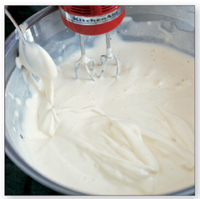
1. Combine the eggs and sugar and beat on high speed until quadrupled in volume.

2. Fold the chocolate mixture with the beaten egg mixture while sifting over the flour.

3. Detach the cake from the sides of the pan by running a metal spatula or small knife along the sides.

4. After the cake has cooled for 10 minutes, transfer it to a cake rack.
Chocolate Soufflé Cakes
Chocolate Soufflé Cakes
These cakes are cakelike on the outside and hot and creamy on the inside—eating one is like eating warm cake with hot melting mousse on top. The soufflé cakes are made in the same way as genoise, except that melted chocolate and butter are folded with the beaten eggs while the flour is being folded in. They are best when the outside is cakelike and the inside molten. To get this effect, freeze the soufflés in their individual ramekins for at least a couple of hours before baking.
The unbaked cakes can be frozen, well covered, weeks before you need them. Just pull them out of the freezer and bake when you want to serve them. You can serve them in their ramekins or you can unmold them onto plates.
MAKES 6 SERVINGS
Room-temperature butter and unsweetened cocoa powder for the ramekins
½ cup butter
8 ounces bittersweet chocolate, coarsely chopped
4 eggs, at room temperature
⅓ cup granulated sugar
3 tablespoons flour
Confectioners’ sugar for sprinkling
Brush six 5- or 6-ounce ramekins with room-temperature butter. Sift cocoa powder over a sheet of parchment paper, pour the powder into one of the ramekins, and turn it until the inside is coated. Pour the excess cocoa powder into the next ramekin and repeat until all have been coated (see
photo).
Combine the butter and chocolate in a heatproof bowl set over a saucepan of simmering water. Stir with a whisk or silicone spatula until smooth and melted. Remove from the heat.
Combine the eggs and granulated sugar and beat on high speed with a stand mixer for about 5 minutes or with a hand-held mixer for about 25 minutes, or until the ribbon stage: when the beater is lifted, the mixture falls in a wide band onto the surface, forming a figure eight that stays for 5 seconds before dissolving.
Pour the egg mixture over the chocolate mixture and fold with a rubber spatula while sifting the flour over the mixture. Alternate between adding flour—about one-fourth at a time—and folding until the flour is no longer visible.
Transfer the mixture to the prepared ramekins and smooth the tops. Cover with plastic wrap and freeze for at least 2 hours.
Preheat the oven to 425°F. Bake the soufflé cakes for 17 to 20 minutes, until risen almost by half.
Sprinkle with confectioners’ sugar and serve. If you want to unmold the soufflé cakes, run a knife around the inside edge of the ramekins. Turn the soufflé cakes over onto plates, lift off the ramekins, and sprinkle with confectioners’ sugar. Serve warm.

1. Melt the butter and chocolate over a saucepan of barely simmering water. Stir with a whisk or silicone spatula until smooth.

2. Beat the eggs and granulated sugar to the ribbon stage, then pour the beaten eggs over the chocolate mixture.

3. Fold together the chocolate and egg mixtures while sifting over flour.

4. Pour the soufflé mixture into the molds. Then cover the soufflés with plastic wrap and freeze for at least 2 hours. Bake until half risen.

5. To unmold the soufflé cakes, run a knife around the inside edge, then invert them onto plates and lift off the molds.
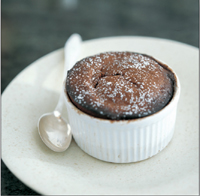
6. The finished soufflé cake can be served in its mold, with confectioners’ sugar sprinkled on top.
American sponge cakes and European sponge cakes, called biscuit, are made with separated eggs. Some recipes call for beating the yolks with sugar to aerate them, but usually it’s the whites that entrap the most air. While biscuit batter is best known as the basis for ladyfingers, it can be baked as a regular layer cake or sheet cake. When a more moist and flexible cake is needed—such as for rolled cakes—melted butter is folded in with the beaten whites and yolks. When folding the whites and yolks together, don’t make the mistake of completely folding them before you start to sift the flour over the mixture or you’ll overwork it and make it heavy.
Fine-Crumb European Sponge Cake (Biscuit)
This basic biscuit cake batter is used to make both ladyfingers and layer cakes. It has a very fine crumb and is excellent for making a cake that will be cut into very thin layers—a 1-inch-thick cake can be sliced into 4 layers with a little practice!
There are two ways you can make thin layer cakes: You can slice a layer crosswise using a serrated knife—which can be awkward, especially if the cake is fragile—or you can pipe the cake batter into disks with a pastry bag. You can make these piped disks any thickness you like by choosing the appropriate-size plain tip and then piping out the batter in a spiral, working from the center and moving out. To keep track of the size of the disks, draw circles on parchment paper and turn the parchment paper over so you can see the circles without the ink or pencil touching the batter. Thin, piped layer cakes cook in about 12 minutes. If the layers are very thin—about ¼ inch—bake them in a 400°F oven instead of the usual 350°F for about 10 minutes, so they cook quickly without time to dry out. Turn it over onto the work surface, wait 5 minutes, and peel away the parchment paper. Fill with buttercream, whipped ganache, classic or fruit mousseline, or chocolate mousse.
MAKES 1 ROUND LAYER CAKE (9 BY 1 INCH), 2 ROUND CAKE DISKS (9 BY ⅓ INCH), 3 LADYFINGER STRIPS (4 BY 14 INCHES), OR 50 LADYFINGERS
Butter and flour for the round cake pan, if using
4 eggs, separated
Pinch of cream of tartar, unless using a copper bowl
½ cup plus 1 tablespoon granulated sugar
1 teaspoon vanilla extract
¾ cup cake flour
Confectioners’ sugar for sifting
Preheat the oven to 350°F for a round cake or 375°F for disks or ladyfingers. Butter and flour a 9 by 1-inch round cake pan, if using.
Combine the egg whites with the cream of tartar (if using) and beat in a stand mixer fitted with the whisk attachment on medium-high speed for about 4 minutes, or until medium peaks form. Add the granulated sugar and beat on high speed for about 1 minute more, or until stiff peaks form.
While the egg whites are beating, whisk together the egg yolks and vanilla in a bowl for about 1 minute, or until smooth.
Transfer the egg white mixture to a large bowl. Pour the egg yolk mixture over it and fold in with a rubber spatula while sifting the flour over the mixture. Alternate between adding flour—about one-fourth at a time—and folding until the flour is no longer visible.
If you are making a round cake, transfer the mixture to the prepared cake pan and bake until the cake bounces back to the touch when you press on it, about 30 minutes.
If you are making ladyfingers, fit a pastry bag with a ¼-inch plain tip (see Note). Draw 2 parallel lines on a sheet of parchment paper to serve as guides. The distance between the lines should equal the desired length of the ladyfingers. Turn over the parchment paper. Pipe the ladyfingers perpendicular to the lines.
If you are using the
ladyfingers to decorate the edge of a cake pipe them so they touch; otherwise, leave about ¼ inch between them. Sift confectioners’ sugar over them and bake for about 12 minutes, or until firm to the touch.
If you are making disks, fit a pastry bag with a ¼-inch tip. Draw 2 circles the desired size of the disks on parchment paper and turn over the parchment paper. Fill the bag with the batter and pipe out the disks, starting in the center and working outward in a spiral. Bake for about 12 minutes, or until firm to the touch. Allow to cool for 5 minutes and peel away from the parchment paper.
Note: You can use a larger tip if you want to make thicker ladyfingers—they will end up just slightly thicker than the tip you use.

1. Beat egg whites to stiff peaks with granulated sugar added during the beating.

2. Whisk egg yolks with vanilla extract, then fold them in with the whites.

3. Sift the flour over the egg white–yolk mixture.

4. Draw two parallel lines on a sheet of parchment paper. The distance between the lines should equal the length of the ladyfingers. Or draw a circle.
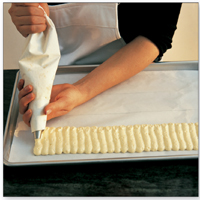
5. Pipe in rows. Here, the ladyfingers are left touching in a row because they’re going to be used on the side of a cake.

6. Sprinkle with confectioners’ sugar.

7. To pipe a disk, start in the center of the circle and spiral outward.
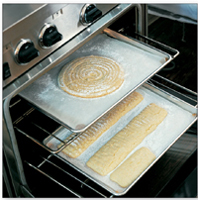
8. Bake until golden brown.

9. Let cool for 5 minutes, then invert and peel the parchment away from the ladyfingers or disks.
Butter-Enriched Sponge Cake
This cake is sometimes used instead of hot milk sponge cake to make rolled cakes because it has a rich buttery flavor and a finer crumb. It’s also flexible and rolls easily. The oven temperature is higher for sheet cakes than it is for layer cakes, because a higher temperature ensures that the cake will cook before it has time to dry out.
MAKES 2 SHEET CAKES (13 BY 17 BY ½ INCH)
8 eggs, separated
Pinch of cream of tartar, unless using a copper bowl
1 cup plus 2 tablespoons granulated sugar
½ cup plus 2 tablespoons butter, melted
1½ cups cake flour
Confectioners’ sugar for sprinkling
Preheat the oven to 400°F. Line two 13 by 17-inch sheet pans with parchment paper.
In a stand mixer fitted with the whisk attachment, beat the egg whites and cream of tartar (if using) on medium-high speed for about 2 minutes, or until medium peaks form. Add ¾ cup of the granulated sugar in a stream, and beat on high for 1 minute longer, or until stiff peaks form.
While the egg whites are beating, in a bowl large enough to fold together the finished cake batter, whisk the egg yolks with the rest of the granulated sugar for about 1 minute, until they are slightly pale.
With a rubber spatula, begin folding together the egg white and yolk mixtures. Place one-quarter of the mixture in a small bowl and fold in the melted butter. Fold the butter mixture back into the egg mixture while sifting over the flour, about one-quarter at a time. Alternate between adding the flour—about one-fourth at a time—and folding until the flour is no longer visible.
With an offset spatula, spread the batter evenly in the prepared pans. Use your thumb to make moats around the cakes to keep the batter from sticking to the sides of the pans. Bake for about 12 minutes, or until the tops of the cakes are firm to the touch. If the cakes seem to be cooking unevenly after 6 minutes, rotate the pans.
While the cakes are baking, sprinkle 2 sheets of parchment paper at least as large as the sheet pans with confectioners’ sugar.
Remove the cakes from the oven and flip out the cakes onto the sheets of prepared parchment paper by setting the cakes right next to the parchment. Immediately peel away the cooked parchment paper from the bottoms of the cakes. Let cool, then trim off any dried-out edges. To learn how to roll the cake,
see photos.
In an ideal world, we’d all have three arms so that we could fold together beaten mixtures while sprinkling over dry ingredients such as flour or sugar. Unless you have a friend who will sift over the dry ingredients while you fold, work in stages by sifting over about one-fourth of the dry ingredients, folding completely, sifting over another fourth, folding again, and so on until all of the flour or sugar has been added.

1. Beat the egg whites to medium peaks; add ¾ cup of the granulated sugar and beat to stiff peaks. Beat the yolks for about 1 minute, or until slightly pale. Add the beaten yolks to the beaten whites and fold together.
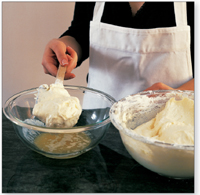
2. Combine one-quarter of the egg mixture with the melted butter in a small bowl. Return this mixture to the rest of the egg mixture in the bowl.

3. Sift over one-quarter of the flour, fold, sift over another one-quarter, and fold. Continue until you use all of the flour.

4. Spread the mixture onto parchment paper–lined sheet pans. Use an offset spatula to spread the cake batter in an even layer on the sheet pans.

5. Use your thumb to make moats around the cakes to keep the cake mixture from sticking to the sides of the sheet pans. Bake until the tops are firm to the touch.

6. Sprinkle 2 sheets of parchment paper with confectioners’ sugar. Turn over the sheet pans with the cakes onto the sheets of parchment paper and immediately peel away the cooked parchment paper.

7. Trim off any dried-out edges of the sheet cakes.
When a cake is made of very fine layers and iced, the effect is striking because the texture of fine delicate cake and rich smooth filling merge together into a very specific combination of light silkiness. This delicate Austrian cake is best known as a layer in the classic torte dobos. This cake batter is almost identical to the classic separated-egg sponge cake (biscuit), except that sour cream or crème fraîche is folded in with the beaten whites and yolks as flour is being sifted over the mixture, which makes the cake more moist and flexible.
Because a dobos is made with as many as 9 thin layers of cake, the batter is often piped into thin disks on parchment paper–lined sheet pans instead of being spread out in cake pans in the usual way. Fill this cake with mousseline, fruit-flavored mousse, or whipped ganache.
MAKES 3 ROUND CAKE DISKS (8 BY ⅓ INCH), 2 ROUND CAKE DISKS (9 BY ½ INCH), OR 1 ROUND LAYER CAKE (9 BY 1 INCH)
Butter and flour for the round cake pan, if using
6 egg yolks, warmed (see Warming Eggs)
½ cup plus 2 tablespoons granulated sugar
¼ cup plus 2 tablespoons sour cream or crème fraîche
5 egg whites
Pinch of cream of tartar, unless using a copper bowl
¾ cup cake flour
Confectioners’ sugar, if making disks
If you are piping disks, preheat the oven to 375°F, draw rounds on parchment paper, turn the paper over, and use it to line a sheet pan. If you have an 8-inch cake ring, use that as a guide to draw the circles. If you are making a round cake, preheat the oven to 350°F and butter and flour a 9-inch round cake pan.
Combine the egg yolks, the ½ cup granulated sugar, and 1 tablespoon of the sour cream and beat in a stand mixer on high speed for about 8 minutes, or until pale and fluffy and quadrupled in volume. Fold in the remaining sour cream.
Beat the egg whites with the cream of tartar (if using) in a stand mixer fitted with the whisk attachment on medium-high speed for about 2 minutes, or until medium peaks form. Add the remaining granulated sugar, and beat on high speed for about 2 minutes more, or until stiff peaks form.
Carefully transfer the egg yolk mixture to a large bowl. Add about one-quarter of the egg white mixture to lighten the mixture, then fold in the remaining egg white mixture with a rubber spatula while sifting the flour over the mixture. Alternate between adding flour—about one-fourth at a time—and folding until the flour is no longer visible.
If making disks, fill a pastry bag fitted with a ¼-inch tip and pipe the batter onto the parchment paper in rings, then sprinkle them with confectioners’ sugar. Bake for about 15 minutes, or until the disks are pale brown and firm to the touch. Allow to cool for 5 minutes, then peel away the parchment paper from the disks.
If making a round layer cake, spread the batter in the prepared cake pan. Bake for about 25 minutes, or until firm to the touch. Allow to cool for 5 minutes.
The effect of very thin layers, separated with thin layers of frosting, is dramatic, satisfying, and elegant to look at. The usual way to go about it is to make layer cakes, let them cool, and then cut them crosswise with a long serrated knife. Ideally, the knife should be longer than the diameter of the cake and you should use a gentle sawing motion with very little force. Don’t give up if you cut one of the layers unevenly or the layers even end up in pieces—just arrange them on the cake as best you can. When the cake’s assembled, no one will see that the layers are broken. You can also start out by making thin sheet cakes—the batter for a 9-inch layer cake also makes a sheet cake 13 by 17 by 3⁄8 inch—and cutting out rounds, or you can put the batter in a pastry bag and pipe rings on sheets of parchment paper—just draw the circles first and turn the paper upside down so the batter doesn’t touch the ink or graphite.

1. Use a round cake ring to draw circles on a sheet of parchment paper. Turn the parchment paper over so you can see the rings through it.
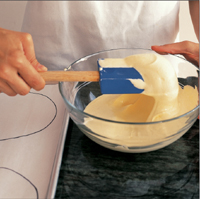
2. Beat the egg yolks with ½ cup of the granulated sugar and 1 tablespoon of the sour cream, until quadrupled in volume. Transfer to a bowl and fold in the rest of the sour cream.

3. Beat the egg whites to medium peaks and add the rest of the granulated sugar. Beat to stiff peaks. Fold in about one-fourth of the egg white mixture with the egg yolk mixture. Fold in the rest of the egg white mixture while sifting over flour.

4. Alternate between adding flour—about one-fourth at a time—and folding until the flour is no longer visible.
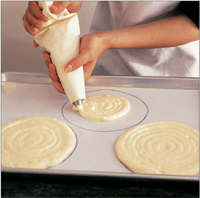
5. Fill a pastry bag with a ¼-inch tip and pipe the batter onto the parchment paper in rings.

6. Sprinkle over confectioners’ sugar. Bake until pale brown and firm to the touch, about 15 minutes. Allow to cool for 5 minutes and peel away the parchment paper.
This cake contains whole eggs plus additional egg whites. The whole eggs are required to provide body—the cake contains very little flour and needs something to hold it together—while the whites add airiness. The steps for making the cake are also somewhat unusual because the flour is mixed with the eggs at the beginning. The almond flour gives the cake a nutty complexity and a dense crumb, which makes it easy to slice into as many as four layers. You can use this cake in the same way as any sponge cake (it may be rolled, for example) and include as many frostings or icings as you like between the layers. To make four layers, you can bake two layer cakes and slice them in half, or you can bake two thin sheet cakes and cut out two rounds from each one. Fill with mousseline, Bavarian cream, or whipped ganache.
MAKES 2 SHEET CAKES (13 BY 17 BY 3⁄8 INCH), 1 SHEET CAKE (13 BY 17 BY ¾ INCH), OR 2 ROUND LAYER CAKES (9 BY 1 INCH)
Butter and flour for the round cake pans, if using
1½ cups almond flour
½ cup plus 1 tablespoon cake flour
¾ cup granulated sugar
4 eggs
6 egg whites
Pinch of cream of tartar, unless using a copper bowl
Confectioners’ sugar, if making a sheet cake
If you are making round cakes, preheat the oven to 350°F and butter and flour two 9-inch round cake pans. If you are making sheet cakes, preheat the oven to 375°F and line two 13 by 17-inch sheet pans with parchment.
Combine the almond flour, cake flour, and ½ cup of the granulated sugar in a food processor. With the motor running, add the eggs, 2 at a time, until the mixture is smooth. Transfer the mixture to a bowl large enough to hold all the batter.
Beat the egg whites with the cream of tartar (if using) on medium-high speed in a stand mixer fitted with the whisk attachment for about 2 minutes or with a handheld mixer for about 3 minutes, or until medium peaks form. Add the remaining granulated sugar, and beat on high speed for 1 to 5 minutes longer (depending on what kind of mixer you are using), until stiff peaks form.
Mix one-fourth of the egg white mixture into the almond mixture until smooth, to lighten the mixture. Using a rubber spatula, fold this mixture with the remaining egg white mixture.
Transfer the batter to the cake pans or sheet pans. If you are using sheet pans, spread the batter with an offset spatula and run your thumb around the edges to make a small moat to keep the edges of the cakes from sticking to the pans.
Bake round cakes for about 25 minutes, or until they bounce back to the touch. Bake sheet cakes for about 15 minutes, or until firm and they bounce back to the touch.
If you are baking sheet cakes, sprinkle 2 sheets of parchment paper as large as the sheet pan with confectioners’ sugar. Run a knife around the edges of the cakes to make it easier to get them out of the sheet pans. Quickly flip out the cakes over the parchment paper as soon as they come out of the oven by placing the cakes right next to the parchment. Peel away the cooked parchment from the bottoms of the cakes. Cut the cakes into rounds or rectangles and layer them with the same fillings you’d use for a sponge cake.
If you are baking round cakes, let them cool for 5 minutes in the cake pans and then turn out onto cake racks.

1. Combine the almond flour, cake flour, and ½ cup of the granulated sugar in a food processor and process to combine. Add the eggs, 2 at a time, and process until smooth.

2. Transfer the almond mixture to a bowl large enough to hold all the batter.

3. Beat the egg whites to medium peaks, add the rest of the granulated sugar, and beat to stiff peaks. Fold about one-fourth of the beaten egg whites into the almond mixture and stir until smooth. Then fold in the rest of the beaten egg whites.
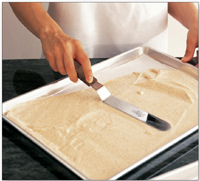
4. If you are making sheet cakes, use an offset spatula to spread the cake mixture over parchment paper–lined sheet pans. Run your thumb around the edges of the cake, forming a small moat. This makes the cake easier to get out of the sheet pan once baked.

5. Bake for about 15 minutes, or until the cake springs back to the touch. When the cake is done, sprinkle it with confectioners’ sugar.

6. Run a knife around the edge of the cake to make it easier to get out of the sheet pan.

7. Sprinkle a sheet of parchment paper with confectioners’ sugar to prevent the cake from sticking. Turn the cake onto the coated parchment paper.

8. Immediately pull away the parchment paper that was baked with the cake.
Almond paste sponge cake is similar to almond flour sponge cake, but has an even more intense almond flavor. The techniques used to make it are straightforward: Almond paste is beaten with egg yolks and sugar, and then the mixture is folded with beaten egg whites. Because the cake is somewhat dense, it works better as a thin sheet cake than it does as a layer cake, and it can be used to make petits fours or rolled cakes.
MAKES 1 SHEET CAKE (13 BY 17 BY 3⁄8 INCH)
½ cup almond paste
6 egg yolks
1 teaspoon vanilla extract
½ cup granulated sugar
1 tablespoon grated lemon or orange zest
5 egg whites
Pinch of cream of tartar, unless using a copper bowl
⅔ cup cake flour
Confectioners’ sugar for sprinkling
Preheat the oven to 375°F. Line a 13 by 17-inch sheet pan with parchment paper.
In a stand mixer with the paddle attachment, beat the almond paste on medium-high speed for about 1 minute, or until it softens. Beat in the egg yolks, one by one, and continue beating for about 1 minute, or until the mixture is smooth. Add the vanilla and ¼ cup of the granulated sugar and continue beating on medium-high speed for about 12 minutes, or until the mixture turns pale yellow. Add the zest.
Beat the egg whites and cream of tartar (if using) on medium-high speed for about 2 minutes, or until soft peaks form. Add the remaining granulated sugar, and continue beating for about 2 minutes, until medium peaks form.
Mix about one-fourth of the egg white mixture with the almond mixture to lighten it. Fold in the rest of the egg white mixture with a rubber spatula, while sifting the flour over the mixture. Alternate between adding flour—about one-fourth at a time—and folding until the flour is no longer visible.
Spread the batter in the sheet pan with an offset spatula and run your thumb around the edge of the cake, making a moat (this will keep the batter from sticking to the sides of the pan). Sprinkle the cake with confectioners’ sugar. Bake for about 17 minutes, or until firm to the touch.
While the cake is baking, sprinkle a sheet of parchment paper as large as the sheet pan with confectioners’ sugar.
When the cake is done, flip it onto the parchment paper and immediately peel away the cooked parchment paper from the bottom of the cake by holding it flat against the cake as you peel. Sprinkle what is now the top of the cake with confectioners’ sugar. Cut the cake into rounds or rectangles for layering.

1. Beat the almond paste in a stand mixer fitted with the paddle attachment for 1 minute to soften it and make it easier to work with.
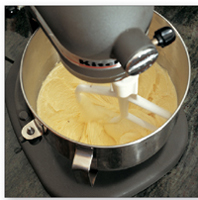
2. Add the egg yolks, vanilla, and ¼ cup of the granulated sugar and beat for about 12 minutes, or until very pale, as shown here. Add flavoring, such as grated orange zest.

3. Beat the egg whites with a pinch of cream of tartar (if using) to soft peaks, add the rest of the granulated sugar, and beat to medium peaks.

4. Combine the almond mixture with the egg whites by first folding about one-fourth of the egg whites with the almond mixture to lighten it.

5. When the egg whites and almond mixture are evenly combined, fold in the rest of the egg whites and sift over the flour while folding.

6. Line a sheet pan with parchment paper—there is no need for buttering or flouring—and spread the mixture evenly on top. Use your thumb to make a moat around the cake to keep the batter from sticking to the sides of the pans (see
photo). Sprinkle the cake with confectioners’ sugar before baking.

7. While the cake is baking, sprinkle a sheet of parchment paper with confectioners’ sugar. When the cake is finished baking, cut around the sides of the sheet pan to help detach the cake.

8. Sprinkle the cake with confectioners’ sugar to keep it from sticking when you turn it over onto the sugared parchment paper.

9. Lift the cake up and flip it over onto the sugared parchment paper.

10. Immediately peel off the parchment paper from the bottom of the cake—don’t wait or the parchment paper will stick. Sprinkle what is now the top of the cake with confectioners’ sugar.
While many sponge cakes contain beaten egg whites, most also contain egg yolks or whole eggs. And while there are cakelike mixtures, such as meringue and dacquoise, made of egg whites, these aren’t sponge cakes. Angel food cake, the only sponge cake made with egg whites alone, is essentially meringue with flour folded in.
Angel Food Cake
Angel food cake, which is sponge cake made only with egg whites (no yolks), must be baked in an ungreased tube pan. It can be made with a handheld mixer, but a stand mixer makes it easier.
MAKES ONE 9-INCH TUBE CAKE
15 egg whites (2 cups)
Pinch of cream of tartar, unless using a copper bowl
1 cup sugar
1 tablespoon lemon juice
1¼ cups cake flour
Preheat the oven to 350°F.
Beat the egg whites and the cream of tartar (if using) with a stand mixer fitted with the whisk attachment on medium-high speed for about 3 minutes or with a handheld mixer on high speed for about 8 minutes, or until medium peaks form. Add the sugar in a steady stream and beat for about 2 minutes more in a stand mixer or 5 minutes more with a handheld mixer, or until medium to stiff peaks form. Don’t overdo it—it’s better to underbeat the egg whites slightly than to overbeat them.
Sprinkle the lemon juice over the egg white mixture and sift over the flour. Alternate between adding flour—about one-fourth at a time—and folding until the flour is no longer visible.
Carefully transfer the batter to the ungreased tube pan. Bake for 40 to 45 minutes, until a paring knife or skewer comes out clean and the top of the cake feels firm and springs back to the touch.
Turn the tube pan upside down and
set over the neck of a bottle to cool for 45 minutes. To remove the cake from the tube pan, roll it on its side and slide a knife or small spatula around the inside of the tube pan against the outside wall and around the tube in the middle. Invert the cake onto a cake rack and lift off the cake pan.
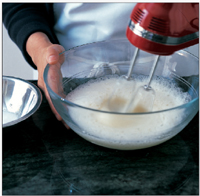
1. Beat the egg whites with cream of tartar (unless using a copper bowl) to medium peaks. Add sugar and continue beating to between medium and stiff peaks.

2. Fold with sifted flour and lemon juice. Spoon the batter into an ungreased tube pan and smooth the surface with the back of a spoon.

3. Bake for about 45 minutes, or until the cake springs back to the touch. Let the cake rest,
upside down on a bottle, for 45 minutes before you unmold it.

4. Cut along the inside of the pan with a small metal spatula or thin knife to release the cake.

5. Invert the cake onto a cake rack and lift off the cake pan.
Butter cakes are made by whipping air into room-temperature butter and sugar and then adding eggs and flour, or by adding melted butter to beaten eggs and sugar. So-called high-ratio cakes are made by combining butter with the dry ingredients and then adding the liquid ingredients.
Most butter cakes are made in much the same way as pound cake, by creaming room-temperature butter with granulated or superfine sugar to work air into the butter. Next, eggs are added, one by one, until they form a creamy emulsion with the butter and sugar. Last, flour is added and worked into the butter mixture as quickly as possible so the butter isn’t overworked. Many butter cakes are made in the same way, with variations at different stages. Among the most common of these variations are cakes in which baking powder is mixed with the flour before the flour is folded into the butter mixture. If an acidic ingredient is being included in the cake, say sour cream or brown sugar, some baking soda may be needed for balance since baking powder is a mixture of baking soda and an acid. The acid in these ingredients causes the baking soda to release carbon dioxide, which leavens the cake.
When liquids such as milk and sour cream are combined with the butter-egg mixture, more gluten is activated and the cake can hold more butter. The result is a cake with all the buttery flavor of pound cake but with a more airy texture. In some butter cake recipes, the eggs are separated and the yolks are mixed with the butter-sugar mixture. The whites are beaten, usually with some sugar, and folded into the batter for extra lightness. One cake that uses all of these leavening ingredients and techniques is a 1-2-3-4 cake or fluffy light butter cake.
Some butter cakes are made like whole-egg sponge cakes (whole eggs are beaten with the sugar) except that they contain far more butter and sometimes heavy cream. These cakes are among the lightest and most delicate of all cakes.
High-ratio cakes, also called dump cakes, are a relatively recent invention—you’ll never see recipes for them that predate the 1940s—and are put together in a different order. To make a high-ratio cake, combine the sliced butter and a small amount of liquid, usually milk, with the dry ingredients before adding the eggs and the rest of the liquid called for in the recipe (see Almond Paste Sponge Cake).
Butter cakes are flavored by adding melted chocolate to the butter-sugar-egg combination or by folding melted chocolate or cocoa powder into the batter at the end. Butter cakes are also flavored with simple ingredients such as spices, poppy seeds, chopped nuts, lemon or orange zest, and vanilla or other extracts beaten with the eggs and butter. Remember also that layer cakes can be flavored with simple syrup.
Some of the richest and lightest textured cakes—very similar to madeleines—are made by combining melted butter (sometimes mixed with cream or milk) with beaten whole eggs and sugar, before adding the dry ingredients. If you want a luxurious cake, with a tight crumb, consider one of these.
Pound Cake
Traditional pound cake is made by combining equal parts by weight of butter, eggs, sugar, and flour; it contains no leavening such as baking powder and, as a result, can be rather dense, but in a satisfying, buttery kind of way. Any airiness that traditional pound cakes do have is a result of beating the butter and sugar for a long time—until the mixture has the consistency of sour cream—and then continuing the beating while adding the eggs. Flour is added at the end and worked as little as possible to avoid making the cake tough. This pound cake is especially moist and buttery because milk is added as well as extra butter. All-purpose flour is used instead of cake flour because you need the extra gluten to absorb the milk and extra butter. If you would like to glaze the cake, try the lemon glaze.
MAKES 1 LOAF CAKE (5 BY 9 INCHES)
Butter and flour for the loaf pan
1¼ cups plus 2 tablespoons butter, sliced, at cool room temperature
1⅓ cups sugar
¼ teaspoon salt
5 eggs
¼ cup plus 2 tablespoons milk
1 teaspoon vanilla extract
2 teaspoons grated lemon zest, optional
1 tablespoon grated lemon zest, optional
1½ cups all-purpose flour
Butter a 5 by 9-inch loaf pan and put a rectangle of parchment paper on the bottom. Flour the sides of the pan. Preheat the oven to 350°F.
In a stand mixer with the paddle attachment, beat the butter, sugar, and salt on high speed for about 8 minutes, or until fluffy. Don’t be tempted to shorten the beating time or your cake will be heavy. Scrape the sides of the bowl with a rubber spatula every minute or so.
In a bowl, beat the eggs, milk, and vanilla. With the mixer on medium speed, add the egg-milk mixture to the butter mixture, one-third at a time. Wait until each addition is thoroughly incorporated before adding more.
The mixture will have the consistency of sour cream or small curd cottage cheese, depending on the temperature. Add the zests to the batter and beat for 30 seconds more.
Turn off the mixer and add all the flour. Beat on low speed for about 5 seconds, or just long enough to mix in the flour with no leftover lumps. Scrape the sides of the bowl with a rubber spatula, then mix for 5 minutes more.
Scrape the batter into the prepared loaf pan. Don’t smooth over the surface of the batter or it may lose some of its airiness—it will settle as it bakes.
Bake for about 1 hour and 15 minutes, or until a toothpick or knife inserted in the center comes out clean. Let cool for 15 minutes before turning out of the pan. Serve sliced. The cake keeps for several days tightly wrapped in plastic.

1. Combine the butter, sugar, and salt in the bowl of a stand mixer with the paddle attachment. Work the butter and sugar together on high speed for about 8 minutes, or until fluffy and creamy.

2. Beat the eggs with the milk and vanilla with the mixer on medium speed. Add this mixture, one-third at a time, to the butter mixture. Wait until each addition is thoroughly incorporated before adding more. Beat the batter until it looks like sour cream or, if the room is cold, small curd cottage cheese.

3. Add the zests to the batter and beat in. Add the flour and beat the mixture just long enough to get rid of the lumps. Transfer the batter to a buttered loaf pan. Don’t smooth over the surface of the batter or it may lose some of its airiness—it will settle as it bakes.
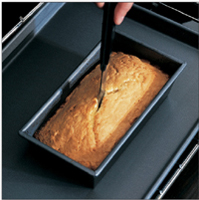
4. Bake until a knife stuck into the middle of the cake comes out with no batter attached, but a crumb or two is okay.

5. If you like, drizzle lemon glaze over the room-temperature pound cake. Let it drip down the sides for a rustic homespun effect.
Some American versions of this cake contain coconut and walnuts, but this version is so rich and chocolaty that these additions aren’t really needed. This cake is traditionally served with a coconut and pecan filling; I suggest instead chocolate or vanilla buttercream. While the finished cake is nothing like a pound cake, the steps are very similar. Butter is beaten with sugar and egg yolks. A mixture of melted chocolate and sour cream is then added to the egg yolk mixture. The egg whites are beaten with sugar to stiff peaks. The egg yolk mixture is then folded into the whites while a mixture of flour, baking powder, and baking soda is sifted over it.
MAKES 2 ROUND LAYER CAKES (9 BY 1½ INCHES)
Butter and flour for the cake pans
¾ cup heavy cream
6 ounces bittersweet chocolate, coarsely chopped
½ cup sour cream
2 teaspoons vanilla extract
1½ cups cake flour, sifted
2 teaspoons baking powder
1 teaspoon baking soda
½ teaspoon salt
1 cup sugar
1 cup butter, sliced, at room temperature
4 eggs, separated
Pinch of cream of tartar, unless using a copper bowl
Preheat the oven to 350°F. Butter and flour two 9-inch round cake pans.
Place the cream in a small saucepan and bring it to a simmer over medium heat. Pour it over the chocolate in a bowl large enough to hold all the finished cake batter. Let sit for about 5 minutes, or until all the chocolate has melted, then whisk the mixture until there are no lumps. Stir in the sour cream and vanilla.
In a bowl, whisk together the flour, baking powder, baking soda, and salt.
In a stand mixer fitted with the paddle attachment, beat ¾ cup of the sugar with the butter for about 2 minutes. Switch to the whisk attachment and beat for 5 minutes more, or until soft and creamy. Beat in the egg yolks, one by one. Beat in the chocolate mixture until well combined.
Transfer the chocolate–egg yolk mixture back to the large bowl. Sift the dry ingredients over the mixture and fold with a rubber spatula just until there are no lumps.
In a stand mixer fitted with the whisk attachment, beat the egg whites and the cream of tartar (if using) at medium-high speed for about 2 minutes, until medium peaks form. Add the remaining sugar, then beat for about 3 minutes more, or until stiff peaks form. Whisk one-fourth of the egg white mixture into the chocolate mixture to lighten it and then fold in the rest of the white mixture, just long enough so you no longer see streaks of egg white.
Transfer the batter to the prepared cake pans and smooth the tops with an offset spatula. Bake the cakes for about 35 minutes, or until they bounce back to the touch or a toothpick inserted in the center comes out clean. Let cool for 5 minutes in the cake pans and then turn out onto cake racks.

1. Pour the simmering cream over the chocolate and let sit for 5 minutes. Stir the chocolate mixture until smooth, then stir in the sour cream and the vanilla.

2. Whisk together the dry ingredients except the sugar.

3. Combine ¾ cup of the sugar with the butter in a bowl. Cream the butter and sugar by hand with a whisk, with a handheld mixer, or in a stand mixer with the whisk attachment.

4. Beat in the egg yolks one by one. Beat in the chocolate mixture until smooth.

5. Sift over the dry ingredients and fold until there are no lumps.

6. Beat the egg whites with the cream of tartar (if using) to medium peaks, add the remaining sugar, and beat for 1 minute more. Whisk about one-fourth of the egg whites into the chocolate mixture.

7. Fold the rest of the egg whites into the chocolate mixture. Transfer the batter to 2 buttered and floured cake pans. Smooth the tops of the cakes with an offset spatula.

8. Bake until the cake bounces back to the touch or a toothpick inserted in the center comes out clean.
This yellow cake has the same ingredients as pound cake but is lighter because it contains milk and baking powder. Because of its lightness, it is the perfect foil for a rich frosting such as you might use for a sponge cake like a genoise.
MAKES 2 ROUND LAYER CAKES (9 BY 1 INCH), OR 1 ROUND LAYER CAKE (9 BY 2 INCHES)
Butter and flour for the cake pans
1¼ cups cake flour
1¾ teaspoons baking powder
¼ teaspoon salt
¾ cup butter, at room temperature
¾ cup plus 3 tablespoons sugar
3 eggs, separated
⅔ cup milk
1 teaspoon vanilla extract
Pinch of cream of tartar, unless using a copper bowl
Preheat the oven to 350°F. Butter and flour one or two 9-inch cake pans.
In a bowl, sift together the flour, baking powder, and salt and whisk to combine.
Cream the butter and the ¾ cup sugar using a heavy wooden spoon, a handheld mixer, or a stand mixer fitted with the paddle attachment. When the butter softens, switch to a whisk. Continue whisking, for about 5 minutes. Whisk in the egg yolks, one at a time, until the mixture is smooth. Whisk in the milk and vanilla, then the flour mixture, ½ cup at a time. Don’t overwork. Transfer the egg mixture to a large bowl to make folding easier.
Beat the egg whites and cream of tartar (if using) for about 2 minutes, until soft peaks form, then beat in the remaining sugar for about 2 minutes, until medium peaks form.
Whisk one-fourth of the egg white mixture into the butter mixture to lighten it. Fold in the rest of the egg white mixture with a rubber spatula. Spread the batter in the cake pans. Bake 1-inch-thick cakes for about 30 minutes or a 2-inch-thick cake for about 40 minutes, or until the cakes bounce back to the touch or until a knife or toothpick inserted in the centers comes out clean. Let cool for 5 minutes in the cake pans and then turn out onto a cake rack.

1. Cream the butter and the ¾ cup sugar with a heavy wooden spoon. When the mixture is creamy and easy to work, switch to a whisk. Whisk in the egg yolks, one at a time.

2. Use the whisk to stir in the milk and vanilla. Then use a whisk to stir in the dry ingredients, ½ cup at a time, just enough to incorporate them.

3. Beat the egg whites with the cream of tartar (if using) to soft peaks, add the remaining sugar, and beat to medium peaks. Whisk about one-fourth of the egg whites into the butter mixture.

4. Fold in the rest of the egg whites. Fill the cake pans and use a rubber spatula to smooth the tops.
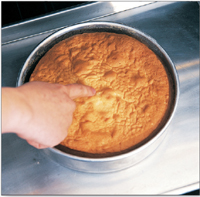
5. Bake until the cake bounces back to the touch or a knife or toothpick poked through the top comes out clean.
Cream and Butter Sheet Cake
Because it has a delicate texture and buttery flavor, don’t use too much frosting or too strongly flavored a frosting on this cake, or its flavor may not come through. Consider frosting this cake with a delicate buttercream flavored with kirsch, raspberry brandy (eau de vie de framboise), Cognac, or poire William. Here are directions to make a sheet cake, but you can also make a 9-inch round layer cake.
MAKES 1 SHEET CAKE (13 BY 17 BY ½ INCH)
1½ cups cake flour
1 teaspoon baking powder
4 eggs, warmed
1 cup granulated sugar
½ cup heavy cream
Zest of 1 lemon, or 1 teaspoon vanilla extract
½ cup butter, melted
Confectioners’ sugar for sprinkling
Preheat the oven to 375°F. Line a 13 by 17-inch sheet pan with parchment paper.
In a bowl, whisk together the flour and baking powder and sift them.
In a second bowl, combine the eggs and granulated sugar and beat on high speed with a stand mixer fitted with the whisk attachment for about 3 minutes or with a handheld mixer for 10 minutes, or until pale and almost tripled in volume. Stir in the cream and zest.
Whisk the butter into the egg mixture. Gently stir the dry ingredients into the egg mixture with a whisk, just long enough to eliminate lumps.
Spread the batter in the prepared sheet pan with an offset spatula. Bake for about 15 minutes, or until firm to the touch.
Take a sheet of parchment paper the same size as the sheet pan and sprinkle it with confectioners’ sugar. Remove the cake from the oven and quickly flip it out over the parchment paper. Immediately peel away the cooked parchment paper from the bottom of the cake. Sprinkle the top of the cake—what was the bottom—with confectioners’ sugar.
To make one 9-inch round layer cake, butter and flour a 9-inch cake pan and preheat the oven to 350°F. Spread the cake batter into the prepared pan, and bake for 25 minutes, until firm to the touch. Let it rest for 10 minutes, run a knife around the edges to detach it, and turn it out onto a cake rack to cool. Slice into layers and frost with buttercream or mousseline.

1. Zest the lemon.
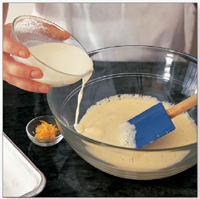
2. Beat the eggs with the granulated sugar until smooth and pale. Stir in the heavy cream and lemon zest or other flavoring such as vanilla.

3. Fold in the melted butter. Add the dry ingredients and whisk until the mixture is smooth and there are no lumps.

4. Spread the mixture evenly over a parchment paper–lined sheet pan with an offset spatula. Bake.

5. Turn out the sheet cake onto a sheet of parchment paper sprinkled with confectioners’ sugar or onto a work surface. Peel back the parchment paper while the cake is still hot—the paper may stick to a cold cake.
This rich, deeply flavored cake can be frosted with chocolate frosting, such as buttercream or whipped ganache, to reinforce the chocolate effect, or a contrasting frosting, such as a kirsch-flavored buttercream, white chocolate mousse, white chocolate whipped ganache, or mousseline, to balance the chocolate.
MAKES 2 ROUND LAYER CAKES (9 BY 1 INCH) OR 1 ROUND LAYER CAKE (9 BY 2 INCHES)
Butter and flour for the cake pans
1 cup cake flour
1½ teaspoons baking soda
1 teaspoon baking powder
¼ teaspoon salt
½ cup butter, sliced, at room temperature
6 ounces bittersweet chocolate, chopped
1 cup sour cream
¾ cup sugar
3 eggs
Preheat the oven to 350°F. Butter and flour one or two 9-inch cake pans.
In a bowl, stir together the flour, baking soda, baking powder, and salt.
Combine the butter, chocolate, and sour cream in a heat-proof bowl and place the bowl over a saucepan of simmering water. Stir until smooth; remove from the heat as soon as the chocolate has melted.
In a large bowl, whisk together the sugar and eggs until smooth. Stir the chocolate mixture into the egg mixture. Sift the dry ingredients over the chocolate-egg mixture while folding with a rubber spatula.
Pour the mixture into the prepared pans. Bake 1-inch-thick cakes for about 25 minutes or a 2-inch-thick cake for about 40 minutes, or until the cakes spring back to the touch or a toothpick inserted in the center comes out clean. Let the cakes cool for 5 minutes and turn them out onto a cake rack. Frost as suggested above.
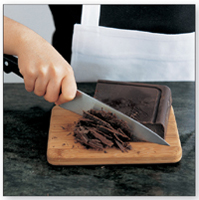
1. Use a chef’s knife to coarsely chop the chocolate.

2. Combine the chocolate, butter, and sour cream in a heatproof bowl. Place the bowl over a saucepan of barely simmering water. Stir until smooth. Remove from the heat as soon as the chocolate has melted.

3. Whisk together the eggs and sugar. Stir the chocolate mixture into the egg mixture. Sift over the dry ingredients while stirring gently.

4. Transfer the batter to one or two buttered and floured cake pans and bake.

5. If you don’t have a cake rack, you can unmold the cake on parchment paper that has been sprinkled with confectioners’ sugar to prevent sticking.
This rich buttery cake is an example of a dump cake in that it contains a high ratio of sugar to flour. It’s best frosted with something relatively light such as stabilized whipped cream or white chocolate ganache.
MAKES 2 ROUND LAYER CAKES (9 BY 1 INCH), OR 1 ROUND LAYER CAKE (9 BY 2 INCHES)
Butter and flour for the cake pans
2½ cups cake flour
1½ cups sugar
½ teaspoon salt
1 tablespoon plus 1 teaspoon baking powder
2 eggs
3 egg yolks
1½ cups milk
2 teaspoons vanilla extract
¾ cup plus 2 tablespoons butter, sliced
Preheat the oven to 350°F. Butter and flour one or two 9-inch cake pans.
In a bowl, whisk together the flour, sugar, salt, and baking powder.
In a second bowl, whisk together the eggs, egg yolks, ½ cup of the milk, and the vanilla.
Add the remaining milk and the butter to the dry ingre-dients. Using a stand mixer fitted with the paddle attachment or a wooden spoon, mix for about 2 minutes, or until well combined. Add one-fourth of the egg mixture. Work until smooth, then work in half of the remaining egg mixture. Add the last of the egg mixture and mix until smooth.
Transfer the batter to the prepared cake pans and smooth the tops with an offset spatula. Bake 1-inch-thick cakes for about 25 minutes or a 2-inch-thick cake for about 35 minutes, or until firm to the touch or a toothpick inserted in the center comes out clean. Let cool for 5 minutes in the cake pans and then turn out onto cake racks.

1. Combine the dry ingredients with a hand whisk or the paddle attachment on a stand mixer. Separately, whisk together the eggs, egg yolks, ½ cup of the milk, and the vanilla.
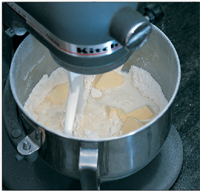
2. Add the butter and the remaining milk to the dry ingredients and work together with the paddle attachment on an electric mixer or with a wooden spoon for about 2 minutes, until the wet ingredients and the butter disappear.
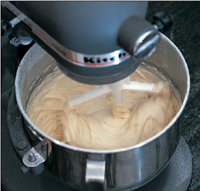
3. When the butter and milk are well combined, add the egg mixture, one-fourth at a time, waiting until the mixture is smooth before adding more egg mixture.
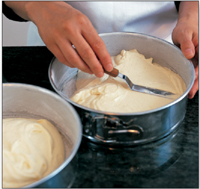
4. Scoop the batter out into one or two buttered and floured cake pans. Smooth off the top of each cake(s) with an offset spatula. Bake until the cake(s) bounce back to the touch or until a toothpick inserted in the center comes out clean.
Dump cakes are also called “
high-ratio” cakes because they contain a higher than usual proportion of sugar to flour. They are called dump cakes because they are made by combining room-temperature butter and a small amount of liquid—milk or cream—with the dry ingredients for about 2 minutes, or just long enough to distribute the ingredients. The rest of the liquids, including beaten egg, are “dumped” in last and the mixture is beaten just long enough to eliminate lumps. The result is light and buttery. If you want to know if a recipe uses the high-ratio method shown here, notice when the butter is added. If it is added at the beginning, with the dry ingredients, it is probably a recipe for a high-ratio cake.
Cakes made with oil have the advantage of staying moist even when cool, whereas cakes made with butter seem heavier when chilled because the butter hardens. When oil is used to bake a cake, it is usually whisked with whole eggs. The egg-oil mixture is then gently stirred with dry ingredients (usually flour, sugar, baking powder, and salt) and any other ingredients, such as carrots, bananas, or pineapple, that are added for texture and flavor.
Carrot cake is especially moist because it is made with oil. Oil, unlike butter, remains liquid at room temperature, so the cake stays moist even when cool. This recipe contains walnuts, which give the cake a delightful crunch, and pineapple, which adds flavor and contrast.
The carrots are best when grated on a box grater. Some graters have tiny punch-outs instead of teeth for the finest grate. When grating the carrots, avoid these and use the smallest teeth. The frosting will go together faster if the ingredients are at room temperature. This recipe is adapted from a very traditional version in Joy of Cooking.
MAKES TWO ½-QUART LOAF CAKES (2 BY 3 BY 5 INCHES), OR ONE 1-QUART LOAF CAKE (5 BY 7 BY 3 INCHES)
Butter and flour for the pans
2 to 3 medium carrots, peeled
⅔ cup flour
½ cup granulated sugar
1 teaspoon baking soda
¾ teaspoon baking powder
½ teaspoon ground cinnamon
¼ teaspoon ground cloves
¼ teaspoon grated nutmeg
¼ teaspoon ground allspice
¼ teaspoon salt
⅓ cup vegetable oil, or a combination of hazelnut or walnut oil and vegetable oil
2 eggs
1 cup chopped walnuts
½ cup drained chopped pineapple
One 8-ounce package cream cheese, at room temperature
¼ cup plus 2 tablespoons butter, at room temperature
1 teaspoon vanilla extract
1¾ cups confectioners’ sugar
Preheat the oven to 350°F. Butter and flour the loaf pans.
To make the cake, cut the carrots into 3- or 4-inch sections and grate them, preferably by hand with a box grater. Hold the carrot sections straight up and down against the grater and grate down to the core. Give the section a quarter turn and grate, again down to the core. Continue in this way until you have only the woody core, which you can throw out. If you are using a food processor, use the finest grater attachment. You should end up with 1 cup finely grated carrots.
In a bowl, whisk together the flour, granulated sugar, baking soda, baking powder, cinnamon, cloves, nutmeg, allspice, and salt, then sift into a large bowl.
In a bowl, whisk together the oil and eggs and stir into the dry ingredients with a rubber spatula. Stir in the walnuts, pineapple, and carrots.
Transfer the batter to the prepared loaf pans and bake for 30 to 55 minutes, or until a toothpick inserted in the center comes out clean. Let cool for 5 minutes before taking the loaves out of the pans. Let the loaves cool on cake racks for 1 hour.
To make the frosting, combine the cream cheese, butter, vanilla, and sugar in the bowl of a stand mixer fitted with the paddle attachment and beat on medium speed for about 10 minutes, or until smooth.
Spread the tops of the loaves with the frosting. Serve in slices.

1. Combine all the dry ingredients with a whisk and then sift them. Whisk together the eggs and oil. Use a rubber spatula to stir the egg mixture gently into the dry ingredients. Stir the walnuts, pineapple, and carrots into the egg mixture.

2. Spoon the batter into buttered and floured loaf pans.

3. Bake the loaves until a skewer, toothpick, or paring knife comes out clean. Let cool for 5 minutes before taking the loaves out of the pans, then let cool on a cake rack for 1 hour.

4. Spread the tops of the loaves with cream cheese frosting.
Basic chiffon cakes are made by beating together egg yolks, oil, and water or other liquid (orange juice is used here) before they are combined with beaten egg whites and the dry ingredients. The combination of oil, beaten egg whites, and flour makes a cake much like angel food but even moister. You can substitute hazelnut oil for some of the vegetable oil to give this cake a deeply nuanced flavor, but this is expensive and by no means essential. You can make chiffon cakes with cake flour, but all-purpose flour gives them a somewhat deeper flavor. The other chiffon cake peculiarity is baking in an ungreased tube pan, so the cake clings to the sides instead of falling as it might in a greased pan. Despite the claims of most recipes, chiffon cake does stick to the pan, but because it is in a tube pan with a removable bottom, it is easy to get the cake out of the pan and sticking isn’t much of a problem.
MAKES ONE 10-INCH TUBE CAKE
1¾ cups all-purpose flour, or 2¼ cups cake flour
1 tablespoon baking powder
1 teaspoon salt
1½ cups sugar
5 egg yolks
½ cup orange juice or water
½ cup vegetable oil, or ¼ cup hazelnut or walnut oil combined with ¼ cup vegetable oil
8 egg whites
1 teaspoon vanilla extract
½ teaspoon cream of tartar, unless using a copper bowl
2⅔ cups dark chocolate glaze
Preheat the oven to 350°F.
In a bowl, whisk together the flour, baking powder, salt, and 1 cup of the sugar. In another bowl, stir together the egg yolks, orange juice, and oil.
Beat the egg whites, vanilla, and cream of tartar (if using) on high speed with a stand mixer for about 2 minutes or with a handheld mixer for about 8 minutes, or until medium peaks form. Add the remaining sugar and beat for 1 to 2 minutes more, or until stiff peaks form.
Sift the dry ingredients over the egg white mixture, about one-fourth at a time, folding with a rubber spatula after each addition until all the dry ingredients are incorporated. Place about one-fourth of the egg white mixture in the bowl with the egg yolk mixture and stir until well combined. Fold this mixture into the egg white mixture with a rubber spatula.
Transfer the batter to an ungreased 10-inch tube pan with a removable bottom. Bake for about 45 minutes, or until the cake bounces back to the touch. Turn the tube pan upside down and
set over the neck of a bottle to cool for 45 minutes.
Set the cake on a cake rack over a sheet pan so you can recoup any glaze that drips off the cake. Prepare a
glaze and spread it over the top of the cake with a long metal spatula. (An offset spatula is somewhat easier to work with.) Spread the glaze over the top of the cake, working out from the center, so the glaze drips down the sides. Spread the glaze around the sides of the cake.
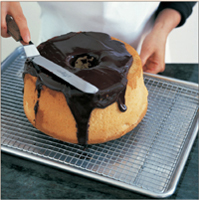
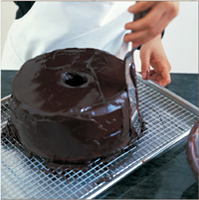

1. Sift together the dry ingredients except ½ cup of the sugar. Beat together the yolks, orange juice, and oil, just long enough to combine them and break up the egg yolks.

2. Add the vanilla and cream of tartar (if using) to the egg whites and beat to medium peaks. Add the remaining sugar and beat to stiff peaks. Sift the dry ingredients over the egg whites while folding.

3. Fold together the egg yolk mixture with the egg white mixture. Pour the batter into an ungreased tube pan with a removable bottom and bake for 45 minutes.

4. The cake is ready when it springs back to the touch.
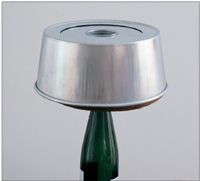
5. As soon as the cake comes out of the oven, stick an empty wine bottle in the center hole and turn over the whole contraption. Let the cake rest, upside down, for 45 minutes.
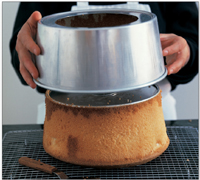
6. Give the cake, still upside down, a little shake while you hold it over a cake rack. If the cake doesn’t come loose, slide a small metal spatula around the sides of the cake, between the cake and the tube pan, and try again.

7. Roll the cake on its side to detach it from the base and the tube in the center. If it won’t come away from the base, slide a thin knife between the cake and the base to detach the cake.

8. Turn the cake upside down and lift off the bottom of the tube pan.
A yeast cake is essentially a kind of light bread that is sweetened at the end with flavored simple syrup. If you like, it’s worth experimenting with a homemade starter (see sponge starter, mature starter, and sourdough starter) instead of using a straight yeast method (shown here). The starter adds depth of flavor to the cake.
If you like the flavor of spirits, babas and savarins are the perfect way to make the most of hard spirits such as rum (the most traditional), whiskey, Cognac, kirsch, or other fruit brandies such as eau de vie de framboise (dry raspberry brandy). Technically, yeast cakes are breads, but babas and savarins, although they are unsweetened, are so cakelike in effect that they seem to belong in this chapter. Babas and savarins are French yeast breads made with the same light dough but in different shapes. Babas are baked in dariole molds—fez-shaped molds that look a little like cocktail jiggers—while savarins are baked in doughnut-shaped molds. Babas are meant for individual servings, but savarins are traditionally baked in larger molds meant to serve 6 or 8 or so. I, however, like to make miniature savarins for individual servings.
If you are setting out to buy savarin or baba molds, try to buy nonstick or even silicone as the dough tends to stick. Once baked, both babas and savarins are soaked in simple syrup flavored with spirits.
MAKES 10 BABAS, OR 20 MINIATURE SAVARINS
Butter for the molds
1⅓ cups flour
½ teaspoon salt
2 eggs
1 teaspoon active dry yeast
1 tablespoon sugar
½ cup warm water
¼ cup plus 2 tablespoons butter, melted
¾ cup sugar
¾ cup hot water
3 tablespoons or more dark rum, whiskey, Cognac, kirsch, or other fruit brandies
1 cup heavy cream
1 tablespoon confectioners’ sugar
1 teaspoon vanilla extract
Butter ten 4-ounce baba molds or 20 miniature savarin molds.
In a stand mixer fitted with the paddle attachment, thoroughly combine the flour and salt so the salt doesn’t touch the yeast. Add the eggs, yeast, sugar, and water. Beat the dough for about 8 minutes on medium speed. At first, the dough will adhere to the sides of the bowl and form strings between the paddle and the walls of the bowl. Continue beating until the dough pulls away from the sides and clings to the paddle attachment. Use a rubber spatula to scrape the inside of the bowl so all the dough gets incorporated. Add the butter and continue beating for 3 to 5 minutes, until the butter disappears. Transfer the dough to a bowl and cover it with plastic wrap; the plastic should touch the dough’s surface to prevent a crust from forming but not be tucked under the dough or it will keep it from rising. Put the dough in a slightly warm place (but no warmer than 80°F or the butter will melt and ooze out of the dough) for about 1½ hours or in the refrigerator overnight, or until the dough has about doubled in size.
Press down on the dough with your fist to flatten it. If making babas, fill the molds halfway with dough; if making miniature savarins, about three-quarters up. Dip your fingers in cold water to make the dough easier to work with and to prevent it from sticking to your fingers. Cover the molds loosely with plastic wrap and let rise in a warm place for about 30 minutes, or until the dough comes almost to the top of the baba molds or slightly over the rim of the savarin molds.
Preheat the oven to 350°F.
Bake for about 30 minutes for babas and 20 minutes for savarins, or until the dough is golden brown and has risen up out of the molds. Take one of the cakes out of its mold and lift it; it should feel light. Let the rest of the cakes cool in their molds for 5 minutes before turning them out.
While the cakes are baking, make the syrup. In a bowl, combine the sugar and water and stir until the sugar is completely dissolved. Let the syrup cool to just slightly warm, or chill it over a bowl of ice water, and add the rum.
Pour the syrup into a bowl. Press each of the babas or savarins down into the syrup for about 1 minute, or until they are well soaked. Gently squeeze each baba or savarin several times while they’re submerged in the syrup, until no more bubbles come up when you squeeze.
To make the whipped cream, whip the cream, confectioners’ sugar, and vanilla extract to stiff peaks and pipe or spoon it into the middle of the savarins. If you’ve made babas, slice them in half vertically and pipe or spoon the whipped cream over the insides. The babas and savarins can also be served plain.

1. Combine the salt with the flour. Add the eggs, yeast, sugar, and water. Work the dough in a stand mixer with the paddle attachment until the dough pulls away from the sides of the bowl. Add the butter and work until no butter is visible.

2. Put the dough in a bowl and cover with plastic wrap. Make sure the plastic wrap touches the surface of the dough to prevent a crust from forming. Avoid wrapping the dough in such a way that it can’t rise. Leave in a warm place for about 90 minutes or overnight in the refrigerator, until doubled in volume.

3. Brush the inside of the baba and/or savarin molds with room-temperature butter.
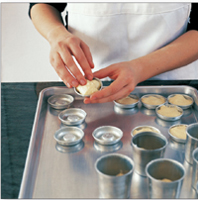
4. Fill the baba molds about halfway up. Fill the savarin molds with just enough dough to come three-fourths of the way up the sides. Let rise, and bake.

5. Prepare a simple syrup. Push the babas and savarins down into the flavored syrup. Gently squeeze each baba and miniature savarin while they’re submerged in the syrup several times, until no more bubbles come up when you squeeze.

6. Serve plain or with whipped cream.
Meringue is a frothy mixture of sugar and beaten egg white. When baked, it becomes crispy and extremely light and starts to dissolve the instant it touches your tongue. There are three kinds of meringue: French, Swiss, and Italian. Familiar crunchy French meringue is piped or spooned into various shapes and slowly baked. It is sometimes piped into round disks that are then used as cake layers. Swiss meringue is almost identical to French meringue, except that it is heated while being beaten, it’s sweeter, and it’s harder. It’s used to make decorations such as the little mushrooms on a bûche de noël. Italian meringue is soft and fluffy and is used as an icing or as the basis for other mixtures such as frozen fruit mousse.
Nut-flavored meringues are made by folding ground nuts such as almonds or hazelnuts and some kind of starch into raw French meringue. The best known is dacquoise, made by adding flour or cornstarch, ground nuts, and sometimes milk to beaten egg whites for French meringue before shaping and baking.
Disks of crisp meringue make wonderful cake layers because their crunchiness contrasts beautifully with the delicate texture of most cakes. You can adjust the thickness of the meringue layers by using different diameter tips with your pastry bag. Keep in mind that thinner disks should be used in cakes that have lighter fillings; if the meringue is too thick and hard, the filling will ooze out when you try to cut or slice the cake.
Trace circles on a sheet of parchment paper. Put a small dollop of meringue in each corner of a sheet pan and lay the parchment paper in the pan. The meringue dollops will keep it in place. Select a plain tip with an opening about the size of the desired thickness of the meringue circles. Start piping meringue at the center of each circle and gradually work out in a spiral pattern until you have filled the circle. To end the piping, quickly pull back the tip, reversing its direction. See
photos.
French Meringue Layer Cake
Meringue’s fragile, brittle, and instant melt-in-the-mouth texture makes up for its lack of flavor. Meringue is never served alone but is juxtaposed with cakes, frostings, ice cream, or other mixtures to provide a bit of crunch. French meringue is made by beating sugar with egg whites until the mixture is very stiff. On a humid day, confectioners’ sugar is folded into the mixture to keep it crunchy once baked. Here we make meringue disks for a cake.
Circles of crisp meringue make wonderful cake layers because their crunchiness contrasts beautifully with the delicate texture of most cakes and frostings. You can make a cake with just meringue disks and frosting such as whipped chocolate ganache, or for greater drama, alternate meringue disks with layers made from a soft cake. You can adjust the thickness of the meringue layers by using different diameter tips with the pastry bag when you pipe out the rounds. Keep in mind that thinner rounds should be used in cakes that have lighter fillings; if the meringue is too thick and hard, the filling will ooze out when you try to cut or slice the cake.
Meringue is ideally baked very slowly so that it dries out rather than actually cooks. If the oven is too hot or the meringue left in too long, it will turn ivory or even brown and the bright snowy white effect will be lost. A convection oven is great for making meringue because the moving air accelerates the drying.
MAKES 2 ROUND CAKE DISKS (9½ BY ¼ INCH), OR 12 ROUND CAKE DISKS (3½ BY ¼ INCH)
5 egg whites
Small pinch of cream of tartar, unless using a copper bowl
¾ cup granulated sugar
1 cup and 2 tablespoons confectioners’ sugar, if it is very humid
In a stand mixer fitted with the whisk attachment, beat the egg whites and cream of tartar (if using) on medium-high speed for about 2 minutes, or until soft peaks form. Add the granulated sugar, and beat for 4 minutes longer, or until stiff peaks form. For meringue that is impervious to humidity, fold in the confectioners’ sugar.
Preheat the oven to 300°F. Draw circles on a sheet of parchment paper, put a dollop of meringue in each corner of a sheet pan to hold the paper in place, and place the paper over on the sheet pan.
Select a tip about the same size as the desired thickness of the rounds and fill the pastry bag with the meringue. Starting at the center of each circle, pipe the meringue, gradually working out in a spiral pattern, until you have filled the circle. To end the piping, quickly pull back the tip, reversing its direction.
Put the meringue in the oven and turn down the oven to 225°F. If you have a convection oven, turn it down to 200°F and put on the convection. Bake for 2 to 4 hours, depending on the humidity, until hard and no longer sticky to the touch.
Note: If you need the meringue to hold its shape for more than a couple of days (for decorations, for example), fold in the confectioners’ sugar as you would on a very humid day.

1. Beat the egg whites and cream of tartar (if using) to soft peaks. Add the granulated sugar and beat to stiff peaks—the whites should stick straight out from the end of the whisk.

2. Draw rounds on a sheet of parchment paper, turn the paper over, and put a dollop of meringue in each corner to hold the paper in place.

3. Select a tip about the same size as the desired thickness of the rounds. Start from the center of each circle and gradually work out in a spiral pattern. To end the piping, quickly pull back the tip, reversing its direction. Bake.
Hazelnut Meringue (Dacquoise)
While rounds of French meringue make wonderful layers in cakes such as the meringue cakes, meringue is brittle and doesn’t have a lot of flavor. For a meringue with an intriguing nutty flavor, fold a mixture of sugar, ground hazelnuts or almonds, and a small amount of flour with uncooked French meringue. Pipe this mixture into disks on a parchment paper–lined sheet pan—buttered tart rings hold the mixture in place, but you can also pipe it directly onto the parchment paper. Bake slowly like meringue.
MAKES ENOUGH FOR 3 ROUND MERINGUE DISKS (9 BY ¼ INCH)
1½ cups hazelnuts or blanched almonds
1¼ cups sugar
3 tablespoons cake flour
Butter for the tart rings
8 egg whites
Pinch of cream of tartar, unless using a copper bowl
Preheat the oven to 350°F. Place the nuts on a baking sheet and toast them for about 15 minutes, or until you can smell their aroma. Remove and set aside to cool. Turn down the oven to 275°F.
In a food processor, grind the nuts with ½ cup of the sugar and the flour for about 1 minute, or until the nuts turn into a fine powder. Take care not to process them until they become oily.
Butter three 9-inch tart rings and set them on parchment paper–lined sheet pans. If you don’t have 9-inch tart rings, draw circles on the parchment paper and turn it over on the sheet pan.
In a stand mixer fitted with the whisk attachment, beat the egg whites and cream of tartar (if using) on high speed for about 4 minutes, or until stiff peaks form. Then beat in the remaining sugar. Continue beating for about 1 minute more, or until the egg whites are stiff and shiny. Transfer the egg white mixture to a large bowl and fold in the nut mixture with a rubber spatula.
Fit a pastry bag with a ⅓-inch plain tip and fill it with the meringue. Starting at the center of each tart ring or circle, pipe the meringue, gradually working out in a spiral pattern, until you have filled the ring or circle. To end the piping, quickly pull back the tip, reversing its direction. Smooth the tops of the disks with an offset spatula.
Bake for about 90 minutes, or until the disks are hard, crisp, and pale brown and the center is firm to the touch. If at any point the dacquoise starts to look too brown, turn down the oven to 200°F. Let cool.
If you’ve used tart rings, slide a knife around the inside of the rings and pull the rings off. Peel away the parchment paper.
Use dacquoise disks in cakes as you would rounds of other cakes, which works best if you construct your cake in a ring or springform pan.

1. Beat the egg whites and cream of tartar (if using) to stiff peaks, add the rest of the sugar, and beat for 1 minute more until shiny. Fold with the ground hazelnut mixture.

2. Pipe the mixture into buttered tart rings set on parchment paper–lined sheet pans; if you are piping free form, draw circles on a sheet of parchment paper and turn it over on a sheet pan. (See
how to fill and use a pastry bag.)

3. Smooth the tops of the disks with an offset spatula.

4. Bake until hard and crisp and pale brown.
In addition to being flavored with nuts, meringue can also be flavored with cocoa and used in the same way—as layers in a cake—as plain meringue. Here, chocolate meringue is piped into logs for decorating the sides of a cake. It can be baked at a slightly higher temperature than plain meringue since discoloration isn’t an issue.
MAKES ENOUGH FOR THE SIDES OF 1 LAYER CAKE (9 INCHES ROUND)
½ cup unsweetened cocoa powder
½ cup confectioners’ sugar
6 egg whites
Pinch of cream of tartar, unless using a copper bowl
½ cup granulated sugar
Preheat the oven to 300°F. Line a 13 by 17-inch sheet pan with parchment paper.
In a bowl, whisk together the cocoa powder and confectioners’ sugar.
In a stand mixer fitted with the whisk attachment, beat the egg whites and cream of tartar (if using) on medium-high speed for about 2 minutes, or until medium peaks form. Add the granulated sugar and beat for about 1 minute more, or until the egg whites are stiff and shiny. Transfer the egg white mixture to a large bowl. Sift the confectioners’ sugar mixture over the egg whites, while folding with a rubber spatula.
Fit a pastry bag with a ⅓-inch tip and fill it with the chocolate meringue. Lift the parchment paper from the sheet pan, pipe a tiny dollop of meringue into each corner of the sheet pan to hold the parchment paper down, then replace the parchment paper. Pipe the meringue in strips that run from one side of the sheet pan to the other, so that you end up with 12-inch logs.
Bake for about 1 hour, or until dry to the touch and when you lift up a piece it feels light.

1. Fold the cocoa-sugar mixture into the beaten egg white mixture.

2. Pipe a tiny dollop of the meringue in each corner of a sheet pan to hold the parchment paper in place during baking.
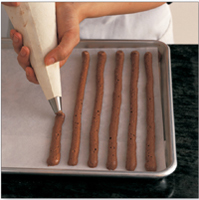
3. Pipe the meringue out in long strips. Bake until crisp.
Cheesecake, with its eggy filling, is the quintessential custard cake. All cheesecakes are custards held together with eggs, egg whites, or egg yolks. The differences in the texture and flavor of the filling are dictated by the use of cream cheese (dense and creamy) or ricotta or other fresh cheese (relatively light). The consistency is also affected by whether you use egg yolks, egg whites, or whole eggs. Egg yolks provide a creamy melting texture, while egg whites make a cheesecake more custardlike.
Cheesecake
Very little can go seriously wrong with a cheesecake, and even when struck with that most common of woes—cracking—a cheesecake is still perfectly edible. The secret to preventing cracking is to make sure the cream cheese, eggs, and sour cream are at room temperature and to bake the cheesecake in a water bath so that it cooks evenly and never gets too hot. If, despite all your efforts, your cheesecake cracks, spread a thin layer of sour cream over the top before serving.
Cheesecakes are easily flavored by adding cocoa, strong coffee, spices, vanilla, or fruit purees. You can also serve cheesecake with a sauce. Pureed and strained frozen raspberries are especially good because their tart acidity sets off the sweetness of the cheesecake.
Many cheesecake recipes call for a graham cracker crust, but this isn’t always worth the bother because the cheesecake filling releases a small amount of liquid as it bakes, making the bottom crust soggy. One solution is to coat only the sides of the cheesecake with graham cracker crumbs after it has baked. This step, too, is optional.
MAKES 1 CHEESECAKE (8 TO 10 INCHES ROUND)
Butter for the pan
Two 8-ounce packages cream cheese, at room temperature
¾ cup sugar
3 eggs, at room temperature
1 egg yolk, at room temperature
1½ cups sour cream, at room temperature
1½ teaspoons vanilla extract
1 teaspoon lemon juice
¼ teaspoon salt
10 graham crackers (optional)
Preheat the oven to 350°F. Brush an 8- to 10-inch springform pan with butter.
In a stand mixer with the paddle attachment, beat the cream cheese with the sugar on medium speed for about 5 minutes, or until smooth. On low to medium speed, add the eggs and egg yolk, one by one. Don’t add another egg until the one before it is completely incorporated. Mix in the sour cream, vanilla, lemon juice, and salt, mixing for about 30 seconds, or just long enough to combine the ingredients.
Pour the batter into the prepared springform pan, wrap the pan in aluminum foil, and place it in a baking pan or roasting pan at least as deep as the springform pan. Fill the baking pan with the hottest water from the tap until the water comes halfway up the sides of the springform pan. Place in the oven and bake for about 90 minutes, or until only a 1-inch-diameter bull’s-eye in the center of the cake moves when you jiggle the pan.
Put the graham crackers in a resealable plastic bag and crush them with your fingers or a rolling pin. If you want them very fine, work them through a strainer after crushing. Or, puree the graham crackers in a food processor.
Remove the cake from the springform pan, but leave it on the base. Hold it up with one hand while using the other to pat the sides with the graham cracker crumbs. Allow to cool. If cracks appear, they can be disguised by covering the top of the cheesecake with a layer of sour cream.
The cheesecake may be flavored with spices, 2 tablespoons (or more to taste) cocoa, 1 tablespoon strong coffee, 1 tablespoon vanilla, or ½ cup fruit puree. If you are adding more than ⅓ cup liquid flavoring to the cheesecake, you should adjust the amount of egg, egg white, or egg yolk in the recipe. Add 1 whole egg per ¾ cup extra liquid, 1 egg white per ⅓ cup extra liquid, or 1 egg yolk per ½ cup extra liquid.

1. Pour the cheesecake batter into the prepared pan.

2. Wrap aluminum foil around the springform pan to prevent the water from seeping in or the batter from seeping out.

3. Put the pan in a container with high sides such as a roasting pan and pour in enough hot tap water to come halfway up the sides.

4. Bake for about 90 minutes, or until the center of the cake moves just a little when jiggled.

5. Take the cake out of the springform pan but leave it on the base. Hold it up with one hand while using the other to pat the sides with graham cracker crumbs.
Once you’ve baked your cake, you can cover it or layer it with various frostings, fillings, and glazes. A glaze is usually a thin coating applied hot to the outside of a cake, while a frosting is thicker and richer and is spread in between the layers and sometimes also on the outside. The most commonly used frostings and fillings are buttercream, mousseline (pastry cream with butter beaten in), and whipped chocolate ganache. Other fillings aren’t really frostings but are preparations such as chocolate mousse, Bavarian creams, fruits, jam, or whipped cream that are used to cover and layer cakes. Most of us are in the habit of using only one filling for our cakes, but a cake can be made more dramatic by using two or more.
Buttercream, crème mousseline, and chocolate mousses can be frozen for up to several months if tightly covered. Fillings that have been aerated with whipped cream (such as creamy chocolate frosting or crème d’or, whipped ganache, or Bavarian creams), however, don’t freeze well and loose their airiness when they thaw. If you want to make a Bavarian cream in advance, it’s best to freeze the crème anglaise and then thaw it and fold it with whipped cream just before you use it.
Few of us can resist the temptation of a cake covered with a rich buttercream frosting. When well made, buttercream still has the flavor of butter—never make it with shortening—in addition to whatever it’s been flavored with. Essentially sweetened and flavored butter, buttercream is made in various ways. By far the simplest, and the version favored by most home cooks, is made by beating butter with confectioners’ sugar and flavoring. The only drawback to homestyle buttercream is the very subtle gritty texture imparted by the cornstarch contained in confectioners’ sugar, but this is subtle enough that most people don’t notice it.
The most popular professional version is made by beating hot sugar syrup into egg yolks, a process that cooks the yolks without curdling them. Butter is then beaten into the sweetened egg yolks. A lighter version is made in much the same way except that egg whites are used instead of yolks. The hot sugar syrup turns the whites into an Italian meringue. After the meringue is cooled, butter is beaten in.
Whichever buttercream you make, beat it thoroughly before you use it. It should have the consistency of sour cream and should have no little holes in it when you examine a little of it on the side of a spatula. The holes come out with continued beating and leave the buttercream, and the finished cake, glossy and smooth. Keep in mind also that because buttercream hardens when chilled, cakes made with buttercream should be allowed to warm to near room temperature before they are served or the frosting will be hard.
Buttercream flavorings seem to be limitless—see a few ideas.
Professional-Style Buttercream
To make professional-style buttercream, based on egg yolks, whisk hot sugar syrup, cooked to the softball stage, into the beaten egg yolks. Continue beating this mixture—called a “bombe” mixture—until cool and then beat in the cold butter.
A stand mixer works best for egg yolk–based buttercream because the egg yolks require a lot of beating to get them to quadruple in volume and to stabilize them before adding the syrup. A handheld mixer will also work, but you’ll need to at least double the beating time.
Here the eggs are warmed slightly, so when the soft-ball stage sugar syrup is added, the yolks don’t cool it and cause it to harden into little pellets.
MAKES 5½ CUPS, ENOUGH FOR A 3- OR 4-LAYER 9-INCH CAKE
2 cups sugar
⅔ cup water plus more as needed
8 egg yolks, slightly warmed (see Note)
1½ cups (1¼ pounds) cold butter, cut into cubes
Flavoring
Put the sugar and water in a heavy-bottomed saucepan and bring to a simmer over medium heat.
While the syrup is cooking, in a stand mixer fitted with the whisk attachment, beat the yolks on high speed for about 8 minutes, or until they have quadrupled in volume and are very pale.
While the egg yolks are beating,
check the syrup with a thermometer or with a spoon. If the syrup is ready before the egg yolks, add 1 tablespoon of water to the syrup and keep simmering.
When the syrup and yolks are ready, turn the mixer to high speed and pour the syrup into the yolks between the whisk and the sides of the bowl. It is important to keep the syrup from touching the whisk or the bowl because it will harden into little globules, which will break off into the buttercream. (Don’t worry, a few are unavoidable.) Continue beating the egg yolk–sugar mixture until it is just slightly warmer than room temperature (hold your hand on the bottom of the mixer bowl; ideally, it should feel neither hot nor cold).
Turn down the mixer speed to medium and add the butter cubes, a small handful at a time. Wait until each batch is absorbed before adding more. Beat for about 10 minutes, or until smooth and fluffy. Beat in the flavoring until fully incorporated.
Spread the buttercream on a cake.
Note: To heat the egg yolks slightly, put the eggs in a bowl of hot water for 5 to 10 minutes before you crack and separate them.

1. Beat the egg yolks on high speed in a stand mixer until pale and quadrupled in volume. With the mixer still on high speed, pour the soft-ball stage sugar syrup into the bowl, between the sides of the bowl and the moving whisk. Beat until the mixture is just slightly warmer than room temperature.

2. Turn down the mixer speed to medium and add the cold butter, cut into cubes, a small handful at a time. Wait until each batch of butter is absorbed before adding more.

3. The finished buttercream is smooth and fluffy.
Italian Meringue Buttercream
Egg white–based buttercream, made by beating butter into Italian meringue, is made in almost the exact same way as egg yolk–based buttercream, except that soft ball–stage sugar syrup is poured into beaten egg whites instead of beaten egg yolks. Most professional chefs prefer buttercream made with egg yolks—probably because of its rich unctuousness—but when a perfectly white buttercream is called for, as on a wedding cake, the pale yellow egg yolk–based buttercream won’t work. You can make the buttercream in the same bowl in which you made the meringue. The finished buttercream has a silky smooth texture and a delicate buttery flavor.
MAKES 5½ CUPS, ENOUGH FOR A 3- OR 4-LAYER 9-INCH CAKE
After you make the Italian meringue, simply add the butter, a handful at a time, to the meringue and beat on medium to high speed with either a stand mixer or a handheld mixer until the butter disappears. Wait until each batch of butter is worked in before adding more. To flavor the buttercream, see
here.
If you’re making a round layer cake, count on 1 cup of buttercream per layer (including the top) for a ⅓-inch-thick layer of frosting and about 1½ cups frosting for the sides. So, a four-layer cake requires a total of 5½ cups of frosting—1 cup for each layer and 1½ cups for the sides. A single layer 13 by 17-inch sheet cake will require about 2 cups.
Quick and Easy Orange Buttercream
Professional-style buttercreams, made with a bombe (hot sugar syrup beaten into egg yolks) or Italian meringue (hot sugar syrup beaten into egg whites), have the advantage of being satiny smooth. But because both of these require using soft ball–stage sugar, a step many of us don’t want to fuss with, homemade-style buttercream, made simply by beating butter with confectioners’ sugar, offers a tempting alternative. Homemade-style buttercream sometimes leaves a very subtle roughness in the mouth that is not noticeable to most people. To eliminate most of this texture, beat the buttercream thoroughly—at least five minutes in a stand mixer—until it has the consistency of sour cream. It gets firmer once it is on the cake and chills somewhat. An orange flavoring is great for buttercream that you want to use to frost delicate white and yellow butter cakes and sponge cakes.
MAKES 5½ CUPS, ENOUGH FOR A 3- OR 4-LAYER 9-INCH CAKE OR 2 SHEET CAKES
1½ pounds butter, sliced, at room temperature
2½ cups confectioners’ sugar
2 tablespoons grated lemon zest, or 2 teaspoons or more orange oil
Using a stand mixer fitted with the paddle attachment or a handheld mixer on high speed or a wooden spoon (see Note), beat the butter for 5 to 10 minutes, until smooth and easy to work. Add the sugar and zest and beat until smooth, starting on low so the sugar doesn’t fly around and then turning the mixer to high. Switch to the whisk attachment or hand whisk and beat for about 5 minutes, or until the butter has the consistency of sour cream.
Note: If using a handheld mixer or a wooden spoon, make sure the butter is at or almost at room temperature (65°F to 67°F) so it is easier to work.
When sugar and water are boiled together, the sugar becomes more concentrated. To make 1 cup of syrup and bring it to the soft ball stage, combine 1 cup of sugar, 2 tablespoons of corn syrup, and ½ cup of water in a heavy-bottomed saucepan. Stir the mixture to dissolve the sugar. Bring the syrup to a simmer and brush down the sides, using a brush dipped in cold water, to prevent crystals from forming. As the bubbles in the simmering syrup get larger, start testing for the soft ball stage. To so this, use a spoon to put a small amount of the hot syrup into some ice water, then pinch the syrup between your thumb and forefinger.
You will notice the syrup going through stages. Early in the process, the sugar will dissolve in the water, so continue boiling. Next, it will form a thread between your two fingers, so wait and test again. Eventually, it will become thick enough to roll into a soft ball with the consistency of chewed gum. If the sugar hardens completely when you stick it in the water, you’ve cooked the syrup too much—it has reached hard crack stage. In that case, add a few tablespoons of water to the hot syrup and start testing again. You also can use a thermometer to know when the syrup has reached the softball stage; it should measure 238°F.
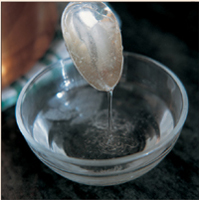
1. Test for the soft ball stage by dripping a little syrup in ice water.

2. The soft ball stage.
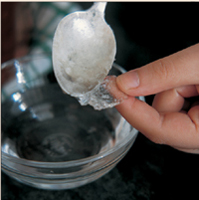
3. The hard crack stage.

4. Testing syrup with a thermometer; soft ball stage is 238°F.
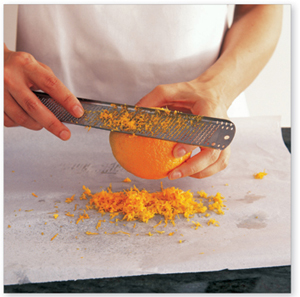
You can flavor buttercream with virtually anything: ground spices such as cinnamon or ginger,
coffee,
chocolate, spirits such as kirsch or Cognac, or
vanilla or
almond extract. Most of these flavorings should be added to taste, a very little bit at a time. Liquid ingredients must be used very sparingly because if you add too much, you’ll make the buttercream too runny—avoid adding more than 1 tablespoon liquid per 1 cup of buttercream. If you want more flavor from a liquid ingredient such as brandy, add it to a simple syrup and brush it onto the cake layers instead of adding it all to the buttercream. All the flavorings listed below should be added to finished buttercream; beat the flavoring in until it’s thoroughly incorporated and the buttercream is light and fluffy. This usually takes about one minute in a stand mixer equipped with the whisk attachment on high speed.
Chocolate Buttercream: Add 2 ounces melted bittersweet chocolate or 1 ounce melted bitter unsweetened chocolate per 1 cup of buttercream. Chocolate makes buttercream firmer, because it hardens when cool; bittersweet and unsweetened chocolate also make buttercream less sweet.
Vanilla Buttercream: Add ½ teaspoon vanilla extract per 1 cup of buttercream.
Hazelnut, Pistachio, or Almond Buttercream: Use ¼ cup nut paste per 1 cup of buttercream. If oil is floating on the top of the container of nut paste, mix it in the can until smooth like peanut butter. If the paste is very stiff and hard to work, transfer it to a bowl and mix it with a heavy-duty wooden spoon or with the paddle attachment of a stand mixer until smooth. Use the paddle attachment of a stand mixer on medium speed to combine the nut paste with the buttercream for about 4 minutes, or until the mixture lightens, then switch to the whisk attachment and beat on high speed for about another 5 minutes, or until the buttercream is airy and smooth.
Chestnut Buttercream: Add 3 tablespoons chestnut puree per 1 cup of buttercream, or more to taste.
Citrus Buttercream: Add 1 teaspoon grated zest or ½ teaspoon citrus oil or 2 teaspoons citrus extract per 1 cup of buttercream, or more to taste.
Coffee Buttercream: For good coffee flavor, add 2 to 4 teaspoons of a strong brew such as espresso or make extrastrong instant coffee (ideally labeled ”dark,“ “French,” or “Italian” roast). Or combine 1 to 2 teaspoons instant coffee with 2 to 4 teaspoons water, and beat this mixture into 1 cup of buttercream.
Buttercream Flavored with Spices: Add ½ teaspoon ground cinnamon or ¼ teaspoon ground cloves per 1 cup of buttercream, or to taste.
Buttercream Flavored with Spirits: Add 1 teaspoon spirits per 1 cup of buttercream, or more to taste. This proportion applies to all spirits: fruit brandies; rum; bourbon or Irish whiskey; grappa or marc; Cognac or Armagnac. Spirits must be full flavored or you’ll need to use too much. Use dry, clear unsweetened fruit brandies such as kirsch (cherry flavor), framboise (raspberry flavor), mirabelle (plum flavor), or poire William (pear flavor). Buy Swiss or French—not American—kirsch or framboise or other eaux de vie; dark rum from Martinique, Jamaica, or Haiti; and authentic Cognac, not just brandy. Don’t hesitate to buy the least expensive bottle of Cognac because the word “Cognac” guarantees a full flavor.
Because buttercream is an emulsion like cream or mayonnaise, it sometimes separates while you are beating it. This is especially true if you are beating cold buttercream you’ve saved in the refrigerator or freezer.
If buttercream separates and starts to look grainy after you’ve added all the butter and flavoring, beat a little longer—5 minutes or so—to see if it comes together on its own. If it still won’t smooth out, put the bowl over a very low flame (provided the bowl is metal) or over a saucepan of simmering water for about 20 seconds and beat again for 5 minutes. You may have to do this once or twice to get it to work.
Here, congealed buttercream left over from another cake is worked over the gentle heat of barely simmering water in a saucepan until a small amount of melted buttercream forms in the bottom of the bowl. It is then beaten with the paddle attachment to soften it and then with the whisk attachment until it’s light, fluffy, and perfectly smooth, with no holes.

1. Put the chopped pieces of buttercream in the metal bowl of a stand mixer and place the bowl over a low flame or simmering water for about 20 seconds, or until you see a little melted buttercream collect in the bottom of the bowl.

2. Work the buttercream with the paddle attachment until it is smooth. Switch to the whisk attachment and beat for 5 minutes more.

3. Check the consistency of the buttercream by spreading a small amount on a spatula. The buttercream should be perfectly smooth, with no little holes.
Glazes are usually shiny, relatively dense, and very rich coatings for the outsides of cakes. They are applied in thinner layers than frosting. Frostings and other fillings, while often very rich, are lighter than glazes and are applied in thicker layers on the inside of cakes and sometimes on the outside as well. While melted chocolate can be used alone as a cake glaze, most chocolate glazes contain cream and/or butter to soften the glaze once it sets.
Ganache, the most popular glaze, is made by combining melted bittersweet chocolate and heavy cream and stirring the mixture until smooth. The hot ganache can be poured over cakes and left to set, or it can be used as a hot sauce for ice cream or profiteroles. You can change the texture and flavor of ganache by adding more or less chocolate to the cream or by whisking in butter, which will make the glaze stiffer when it sets. Ganache is easy to flavor with a small amount of strong coffee, liqueurs, or spirits such as whiskey, brandy, or grappa.
Crème d’or is made by folding melted chocolate into whipped cream.
Chocolate butter glaze is simple to make: Just melt together equal parts butter and chocolate with a little corn syrup. The corn syrup helps the glaze keep its sheen after it has been applied to a cake.
When it’s hot, ganache has the consistency of rich chocolate sauce; when cold, it sets into a firm glaze. For this reason, ganache can be used both as a sauce and as a glaze for cakes. Recipes vary—the ratio of cream to chocolate differs—and some include butter so the ganache sets up more firmly when cold. To imagine the taste and texture of ganache made with butter, think of a hot fudge sundae in which the chocolate has hardened on the cold ice cream. A classic ganache, made with equal parts cream and chocolate, will still harden, but not as dramatically as it does when made with butter. When ganache is whipped, it becomes fluffy and pale and makes a perfect frosting. One approach for icing a cake is to use whipped ganache between the layers and unwhipped ganache for the top and sides. Here is the classic recipe, calling for equal parts heavy cream and bittersweet chocolate. For a white chocolate version, see the variation.
MAKES 1¾ CUPS, OR 2 CUPS WHEN WHIPPED, ENOUGH FOR 2 LAYERS
8 ounces bittersweet chocolate, chopped
1 cup heavy cream
Place the chocolate in a heatproof bowl.
Bring the cream to a simmer and pour it over the chocolate. Let the mixture sit for about 10 minutes, or long enough to melt the chocolate. Stir the ganache with a rubber spatula for 1 minute and then switch to a whisk and stir until smooth and the consistency of sour cream. If you are using the ganache to ice a cake, let it cool for 4 or 5 minutes before you use it (or set it over an ice water bath to cool quickly), so it thickens and adheres better to the cake. If you are using it as a sauce, use it right away.
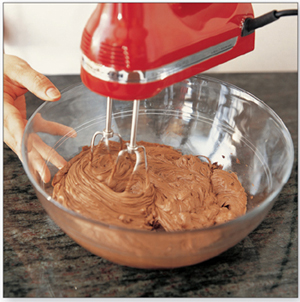
For a lighter frosting, beat or whip the ganache until it is light and fluffy.
If you want a lighter frosting, use a stand mixer or a handheld mixer to whip the
ganache until it is light and fluffy. To judge this, notice that early during the beating, the ganache has the consistency of cream cheese. When it is ready after anywhere from 2 to 10 minutes in a stand mixer—the time depends on the chocolate and the exact temperature—it should have the consistency of sour cream.
White chocolate ganache is made in the same way as dark chocolate ganache except that white chocolate is used instead of bittersweet dark chocolate. Make sure the ganache is cool before whipping it or it will break and never get fluffy. Put a bowl of just-made ganache in a bowl of ice water, to cool, if necessary. Whip only until it’s fluffy—if you overbeat it, the cream will turn to butter. The amount of time it takes to whip white chocolate ganache depends on the brand of chocolate and the temperature of the ingredients, and can range from 30 seconds to 4 minutes.

Pour simmering cream over the chocolate.
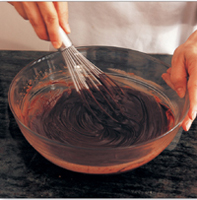
Stir until smooth and cover with plastic wrap or use right away.

To whip ganache (white chocolate ganache is shown here), put the bowl of just-made ganache in a bowl of ice water to cool it.

Beat until fluffy and stiff, like beaten egg whites. Don’t overbeat, or you’ll get white chocolate butter.
Creamy Chocolate Frosting (Crème d’Or)
Except for a little vanilla, this frosting contains the same ingredients (chocolate and cream) in the same proportions as ganache, but it is prepared differently—the chocolate is melted by itself and then folded with whipped cream. Because crème d’or is made with whipped cream, it should be folded just long enough to incorporate the chocolate or the cream will turn to butter. Crème d’or is lighter and more like whipped cream than whipped ganache.
MAKES 2 CUPS, ENOUGH FOR 2 LAYERS
8 ounces bittersweet chocolate, coarsely chopped
1 cup heavy cream
1 teaspoon vanilla extract
Melt the chocolate in a bowl set over a saucepan of simmering water. Take care not to let any moisture touch the chocolate, or it will seize. When most of the chocolate has melted, remove from the heat and stir until perfectly smooth. If the chocolate doesn’t completely melt, put the bowl back over the simmering water for 1 to 2 minutes while scraping the sides of the bowl with a rubber spatula.
Put the cream and vanilla in a bowl large enough to hold the finished frosting or the bowl of a stand mixer and place it in the freezer for 5 minutes. Then, beat the cream to soft peaks (the cream droops off the end of the whisk).
If you are making the frosting by hand, pour the melted chocolate down the side of the bowl containing the whipped cream and use a rubber spatula to fold the mixture together until completely homogeneous. If you are making it in a stand mixer, turn the mixer speed to low when the cream reaches soft peaks and pour the chocolate over the whipped cream while beating. Keep the frosting refrigerated until you are ready to use it. If it gets too warm, it can melt and lose its airiness.

1. Melt the chocolate and beat the cream and vanilla to soft peaks. Pour the melted chocolate down the side of the bowl into the whipped cream.

2. Fold together until you don’t see any cream.
Before coating a cake with hot icing, the cake should be sealed in one of two ways: First by coating the cake with half of the icing, refrigerating the cake until the icing hardens, and then covering with a second coat; or, by “crumb” coating the cake with a thin layer of frosting such as buttercream (use the same frosting that is in the cake), chilling the cake until the coating hardens, and then pouring over the hot glaze. Place the cake on a cake rack set on a sheet pan so you can reuse the glaze that runs off the cake. Allow the glaze to harden before serving.

Some bakers prefer this rich glaze, made by melting together chocolate and butter, to ganache and crème d’or, because it is very firm when it sets and it keeps its sheen. Usually this glaze contains a little corn syrup to stabilize it and keep it from taking on a matte appearance when cold. You can also make a hybrid glaze by including butter in a standard ganache—the butter makes it richer and firmer when cold. If you’re using this glaze after it is no longer pourable, put the bowl over a low flame (if the bowl is metal) or over a saucepan of simmering water while working the glaze with a whisk until it has a consistency you can pour.
MAKES 1⅓ CUPS, ENOUGH TO COVER THE TOP AND SIDES OF A 9-INCH ROUND CAKE
8 ounces bittersweet chocolate, chopped
1 tablespoon corn syrup
½ cup butter, cubed or sliced
Melt the chocolate with the corn syrup and butter in a heatproof bowl set over a saucepan of simmering water. Stir with a rubber spatula until smooth.
White Chocolate Glaze
White Chocolate Glaze
This glaze is very firm and rich once set because it is pure white chocolate, except for a small amount of cream. Use this glaze on the top and sides of a cake to create a thin hard coating. This recipe makes just enough to cover the top of a 9-inch round cake, so double the amount to glaze the sides as well. If you want to use a white chocolate filling between layers, use whipped white chocolate ganache or white chocolate mousse.
MAKES 1 CUP, ENOUGH TO COVER THE TOP OF A 9-INCH ROUND CAKE
8 ounces white chocolate, chopped
¼ cup heavy cream
Combine the chocolate and cream in a heatproof bowl set over a bowl of simmering water. Stir with a rubber spatula just long enough to melt the chocolate, then remove from the heat. Stir until the mixture is smooth. Use right away.
Chocolate mousse is stiff because chocolate hardens when it’s cold. Fruit mousses, on the other hand, have to be made stiff, usually with gelatin. Fruit mousses can be served alone, but they are especially well suited for layering in cakes.
Professional pastry chefs use a variety of methods to make fruit mousses and may base their mousses on combinations of bombe mixture, Italian meringue, pastry cream or crème anglaise combined with gelatin and the appropriate fruit puree. Curds, such as citrus curds or passion fruit curd also make marvelous mousses when folded with whipped cream and dissolved gelatin. While mousses made using each of these methods have subtle differences in texture, the best and easiest to make are Bavarian creams.
Bavarian creams are among the most delicious fruit mousses because they’re light and airy, yet rich and creamy. A Bavarian cream is made by folding whipped cream into a flavored crème anglaise (crème anglaise is a kind of liquid custard) containing gelatin. The secret to a successful Bavarian cream is using whipped cream beaten to soft peaks and the correct amount of gelatin. Overbeaten or underbeaten whipped cream will make a Bavarian cream dry or heavy. Too much gelatin makes a Bavarian cream rubbery; too little, and the Bavarian cream never sets. Provided you serve the Bavarian cream cold, a teaspoon of powdered gelatin per 1 cup of liquid (including the cream before beating) is usually right. Virtually any fruit can be pureed, strained, and substituted for the strawberries used here, but beware of tropical fruits such as mangos, papayas, and pineapples, which contain enzymes that break down gelatin. A puree of tropical fruit must be brought to a boil to break down its enzymes before you can use it with gelatin.
To make a classic Bavarian cream, you must first make a custard sauce, a crème anglaise.































































































































































